Shopping? Try:



 |

 |
Digital Photography News Archive!
October 2000
Back to current
news Back to Archive Index
Back to Archive Index
Monday, October 30, 2000
Targus announces new line of digicam cases!
By Michael Tomkins, The Imaging Resource
(Monday, October 30, 2000 - 18:56 EST)

Targus Inc. has announced availability of three new lines of carrying cases for digital cameras and camcorders. The cases, available in a variety of styles and colors, were designed by Targus' recently acquired subsidiary, Studio Roundhouse in Santa Monica, CA. "The Targus line of digital camera cases represents our response to the integration of digital imaging with mobile computing," said John Sargent, Vice President of Communications for Targus. "Targus is the recognized leader in mobile computing accessories, and we will now offer the marketplace outstanding carrying solutions for digital cameras and camcorders." "The Targus line of digital camera cases represents our response to the integration of digital imaging with mobile computing," said John Sargent, Vice President of Communications for Targus. "Targus is the recognized leader in mobile computing accessories, and we will now offer the marketplace outstanding carrying solutions for digital cameras and camcorders."
The three lines of digital camera cases are known as Pro Black, Sport, and Casual. With camera protection in mind, high-density foam surrounds the main compartments, and interior walls and dividers are covered with a soft, plush lining, called Sport Prolene. In addition, the exterior of the cameras cases feature a 420 denier twill nylon to protect against long-term wear.
 All of the cases have extra storage areas for items like memory cards, and the larger camera and camcorder cases have additional accessory storage compartments for batteries, power adapters, and connector cables. The cases feature a 'Neoprene Comfort Stretch Strap' which reduces shoulder and neck strain, and the smaller models include belt loop straps. All of the cases have extra storage areas for items like memory cards, and the larger camera and camcorder cases have additional accessory storage compartments for batteries, power adapters, and connector cables. The cases feature a 'Neoprene Comfort Stretch Strap' which reduces shoulder and neck strain, and the smaller models include belt loop straps."Targus' wide variety of solutions are necessary because the photo market today is comprised of a diverse group of users ranging from novices to professionals," said Sales Manager Chris Flaharty, who led the product design for Targus. "In response to market feedback, we have employed new, innovative materials that strike a balance between function and style." The three lines (Pro Black, Sport and Casual) vary in style and design. The Pro Black Line is designed for corporate users who want professional looking cases in traditional black. The Sport Line features three colors (Charcoal, Silver, & Metallic Blue), which Targus says was designed to "mirror trends in technology product colors from major manufacturers like Sony, Kodak and Olympus". The Casual Line comes in Khaki with subtle accent trims for a more relaxed look. The cases are designed to be compatible with virtually all digital cameras and camcorders. The complete list of new cases is as follows: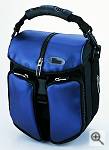 DPBC01 Pro Black Digital Camera Case (small) - $11.99 DPBC01 Pro Black Digital Camera Case (small) - $11.99- DPBC02 Pro Black Digital Camera Case (medium) - $17.99
- DPBC03 Pro Black Digital Camera Case (large) - $19.99
- DPBP01 Pro Black Photo Case (small) - $29.99
- DPBP02 Pro Black Photo Case (medium) - $39.99
- DPBP03 Pro Black Photo Case (large) - $49.99
- DSCL01 Digital Sport Camera Case (large, Charcoal) - $19.99
- DSCL02 Digital Sport Camera Case (large, Silver) - $19.99
- DSCL05 Digital Sport Camera Case (large, Metallic Blue) - $19.99
- DSCM01 Digital Sport Camera Case (medium, Charcoal) - $17.99
- DSCM02 Digital Sport Camera Case (medium, Silver) - $17.99
- DSCM05 Digital Sport Camera Case (medium, Metallic Blue) - $17.99
- DSCS01 Digital Sport Camera Case (small, Charcoal) - $12.99
- DSCS02 Digital Sport Camera Case (small, Silver) - $12.99
- DSCS05 Digital Sport Camera Case (small, Metallic Blue) - $12.99
- DSPL01 Digital Sport Photo Case (large, Charcoal) - $39.99
- DSPL02 Digital Sport Photo Case (large, Silver) - $39.99
- DSPL05 Digital Sport Photo Case (large, Metallic Blue) - $39.99
- DSPM01 Digital Sport Photo Case (medium, Charcoal) - $29.99
- DSPM02 Digital Sport Photo Case (medium, Silver) - $29.99
- DSPM05 Digital Sport Photo Case (medium, Metallic Blue) - $29.99
- DSSL01 SLR Camera Case (Charcoal) - $29.99
- DSSL02 SLR Camera Case (Silver) - $29.99
- DSSL05 SLR Camera Case (Metallic Blue) - $29.99
The Targus digital camera cases range in price from $11.99 to $49.99. The products can be purchased from the company's network of resellers, by calling 877.4.TARGUS, or (by the end of this month) from the company's web site, www.targus.com.

Source: Yahoo! Finance / Business Wire

Casio planning to launch new digicam in November!
By Michael Tomkins, The Imaging Resource
(Monday, October 30, 2000 - 18:49 EST)
 A news item over at Nikkei BP Network's AsiaBizTech website notes an upcoming digital camera from Casio Computer Co. Ltd. of Japan. The Casio LV-10, to be launched in November, is an entry-level camera with a 300,000 pixel CMOS sensor, optical viewfinder, built-in flash, and USB connectivity. Here's the full details as we have them: A news item over at Nikkei BP Network's AsiaBizTech website notes an upcoming digital camera from Casio Computer Co. Ltd. of Japan. The Casio LV-10, to be launched in November, is an entry-level camera with a 300,000 pixel CMOS sensor, optical viewfinder, built-in flash, and USB connectivity. Here's the full details as we have them:- Casio LV-10 digital camera
- 300,000 pixel CMOS image sensor yields images of 640 x 480 or 320 x 240 pixels
- Optical viewfinder, top-mounted LCD info display (?), unknown if the camera features an LCD display for framing/review of images
- 4MB of non-removeable EEPROM flash memory gives 60 images at the higher resolution, or 120 at the lower resolution
- Built-in flash
- USB connectivity
- Power from 2 AA batteries (rated to give 900 continuous shots)
- Dimensions of 94 x 63 x 34mm, weighs 120 grams
- Expected to ship in Japan at the end of November, with a price of ¥9,800 (US$91)
 The AsiaBizTech page has a photo of the camera... The AsiaBizTech page has a photo of the camera...
Source: AsiaBizTech Casio LV-10 news item

Simple announces 512MB solid state CF card!
By Michael Tomkins, The Imaging Resource
(Monday, October 30, 2000 - 18:36 EST)
 Simple Technology Inc. has announced today what it is billing as "the highest capacity CompactFlash card in the world". The company's new 512MB CompactFlash card type II uses proprietary Stacking Technology. Simple Technology Inc. has announced today what it is billing as "the highest capacity CompactFlash card in the world". The company's new 512MB CompactFlash card type II uses proprietary Stacking Technology."This is another product showcasing Simple Technology's leadership in Flash card technology and high-density packaging," said Manouch Moshayedi, chief executive officer of Simple Technology. "With the introduction of the 512 we have surpassed global competition in the high density CompactFlash card. Today's highest-density Flash component is a 512 MBIT chip which is equal to 64MB of storage," said Mark Moshayedi the chief technology officer of the company. "We combined this latest silicon wafer with our own patented IC Tower(TM) stacking technology and produced the highest density CompactFlash card available in the world, this card also uses a high speed controller which allows write speeds of up to 3.0MB per second." Simple Technology's high-density 512MB card is targetted at a variety of markets, ranging from professional digital cameras, PDAs, MP3 players and other consumer products. Industrial applications include telecommunications, networking and embedded computing."Serving this class of products to such a wide variety of users -- OEMs to consumers -- is only possible through a comprehensive network of engineering, manufacturing and focused sales and marketing channels", said Jeanclaude Toma, vice president of marketing at Simple Technology.Simple Technology's 512MB CompactFlash card has a suggested retail price of $1,599.00. The previous highest capacity card we were aware of was Delkin's 448MB Type-II card; Simple's previous highest capacity card was a 320MB Type-II card.
Source: Yahoo! Finance / PR Newswire

Zing announces new Chairman, President and CEO!
By Michael Tomkins, The Imaging Resource
(Monday, October 30, 2000 - 15:22 EST)
 Zing Network Inc. announced today that Mark Platshon has been promoted to Zing Chairman, where he will continue to focus on the company's high-level strategy and new opportunities to support that strategy. Chief Operating Officer David Ezequelle assumes the President and CEO title from Platshon, and will manage the company's growth and evolution. Zing Network Inc. announced today that Mark Platshon has been promoted to Zing Chairman, where he will continue to focus on the company's high-level strategy and new opportunities to support that strategy. Chief Operating Officer David Ezequelle assumes the President and CEO title from Platshon, and will manage the company's growth and evolution.
Zing's vision, says the press release, is "to help people stay connected with family and friends by giving them an easy-to-use and complete range of digital photography services and products". The company notes that it will continue to build the Zing Network, based on relationships with camera and scanner companies, computer hardware and software developers, and Web communities."It's with great pleasure that we announce David's promotion to CEO," said Platshon. "Zing has arrived as the clear winner in online photography by acquiring a large, active audience and key partnerships with device manufacturers. David has demonstrated the ability to maximize commerce and sponsorship revenue generated from this Network."
"This is a natural progression and focuses us on opportunities that we believe are critical to our continued success," said Ezequelle. "Our recent partnerships with device manufacturers including Hewlett Packard, Konica and Sony, have attracted the attention of other industry leaders who have expressed increased interest in working with Zing Network on a wide range of efforts around the world. As Chairman, Mark is able to focus on our 'big-picture' strategy and vision." David Ezequelle founded what Zing describes as "one of the earliest commerce sites on the web", WebShopper.com, which launched in 1996. In 1999, he founded ToolSource.com, a site for professional tools and equipment. Most recently, he was "entrepreneur-in-residence" at Alloy Ventures, where his focus was e-commerce, media convergence and Web infrastructure opportunities. He also brings more than 20 years of management experience to Zing, including Publisher of many Ziff-Davis titles.
Source: Yahoo! Finance / Business Wire

Omnivision announces USB camera reference design!
By Michael Tomkins, The Imaging Resource
(Monday, October 30, 2000 - 12:45 EST)
 OmniVision Technologies Inc. has today announced its new dual-mode digital still camera chip-set. The chip set, featuring hardware compression image data, is designed for rolling snapshots and USB camera applications, the company says. The dual-mode camera design comprises an OV651 DSC Microcontroller and an OV681 Dual-Mode JPEG USB Controller and is used with either VGA or CIF image sensors. OmniVision Technologies Inc. has today announced its new dual-mode digital still camera chip-set. The chip set, featuring hardware compression image data, is designed for rolling snapshots and USB camera applications, the company says. The dual-mode camera design comprises an OV651 DSC Microcontroller and an OV681 Dual-Mode JPEG USB Controller and is used with either VGA or CIF image sensors."OmniVision's charter is to deliver low-cost camera technology to the general public," said Hank O'Hara, vice president of worldwide sales for OmniVision. "With our new dual-mode digital camera chip-set, we are providing an affordable way by which consumers can capture, store and manipulate images from remote locations. This technology paves the way for exciting new applications in consumer products." The dual-mode camera reference design features four megabytes of SDRAM memory, enabling storage of two minutes of rolling still QCIF snapshots taken at five frames per second or up to 220 JPEG compressed images. The camera can either be tethered to the PC or detached for mobility. The camera can be connected to a PC via a USB port, and either used as a tethered camera or stored pictures downloaded. It operates in either single shot, multiple shot or self-timer mode, has the ability to compress and store video using JPEG hardware image compression, and provides status display on a separate LCD. OmniVision offers a complete reference design for its dual-mode digital camera application that it feels enables rapid design cycles and minimum time-to-market for customers.
OmniVision offers the chip-set with either its VGA or CIF camera chip. When combined with OmniVision's two backend chips, the OV681 and OV651, and customer memory, the chip-set becomes a complete digital camera that Omnivision claims features all the functionality of a regular camera, including automatic gain control, white balance and exposure control. The CIF and VGA modules support a range of operating systems.
The dual-mode CIF digital camera chip set is currently available for $14 in 10K unit quantities. The dual-mode VGA digital camera chip set is currently available for $19 in 10K quantities.
Source: Yahoo! Finance / PR Newswire

Steve's Digicams posts Iomega FotoShow review!
By Michael Tomkins, The Imaging Resource
(Monday, October 30, 2000 - 11:58 EST)
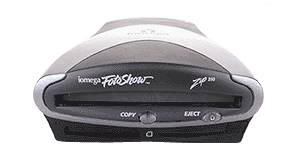
 Our friends over at Steve's Digicams have posted a review of Iomega's interesting FotoShow set-top box. If you're not familiar with the FotoShow, it is a $299 box which consists of a Zip drive with built-in CompactFlash and SmartMedia slots which allows digital camera owners to copy their images to 100MB or 250MB Zip disks when out in the field, and later view and edit the photos on a TV without the need for a computer. The unit also doubles as a Zip drive for your computer, allowing you to copy images to/from your Zip disks when you're back in front of your USB-equipped PC or Mac computer. Here's part of Steve's conclusion: Our friends over at Steve's Digicams have posted a review of Iomega's interesting FotoShow set-top box. If you're not familiar with the FotoShow, it is a $299 box which consists of a Zip drive with built-in CompactFlash and SmartMedia slots which allows digital camera owners to copy their images to 100MB or 250MB Zip disks when out in the field, and later view and edit the photos on a TV without the need for a computer. The unit also doubles as a Zip drive for your computer, allowing you to copy images to/from your Zip disks when you're back in front of your USB-equipped PC or Mac computer. Here's part of Steve's conclusion:"I can see Iomega selling quite a few of these devices. It is handy and quite easy to learn how to use. For those with a limited number of flash memory cards it could be a real Godsend on a vacation. It also gives you a way to enjoy the day's photos on the TV set at the hotel. " For the full story, visit Steve's Digicams' Iomega FotoShow review, which features numerous pictures of the unit itself and its TV interface, as well as descriptions of how it works and a detailed conclusion.
Source: Steve's Digicams' Iomega FotoShow review

Sunday, October 29, 2000
Full Review of Olympus D-490 Zoom posted!
By David Etchells, The Imaging Resource
(Sunday, October 29, 2000 - 18:31 EST)
 Well, it's another week (plus a little bit), but the roster of Olympus digicam reviews continues with the long-delayed review of the Olympus D-490 Zoom. This is actually one of the more eagerly-anticipated reviews on the site, judging by the email we've received. A 2 megapixel update of Olympus' very popular 1.3 megapixel 400-series models, the 490 Zoom incorporates all the features of the previous (and highly successful) D-460 Zoom, and adds a USB interface and movie capability. A very cost-effective 2 megapixel camera, with a nice range of features (including a 3x zoom lens and variable ISO from 100 to 400) and very good picture quality. Check out the review for all the details! Well, it's another week (plus a little bit), but the roster of Olympus digicam reviews continues with the long-delayed review of the Olympus D-490 Zoom. This is actually one of the more eagerly-anticipated reviews on the site, judging by the email we've received. A 2 megapixel update of Olympus' very popular 1.3 megapixel 400-series models, the 490 Zoom incorporates all the features of the previous (and highly successful) D-460 Zoom, and adds a USB interface and movie capability. A very cost-effective 2 megapixel camera, with a nice range of features (including a 3x zoom lens and variable ISO from 100 to 400) and very good picture quality. Check out the review for all the details!
Source: IR Review of Olympus D-490 Zoom

Saturday, October 28, 2000
Steve reviews EOS D30, Digital Outback begins DCS660 report!
By Michael Tomkins, The Imaging Resource
(Saturday, October 28, 2000 - 0:56 EDT)
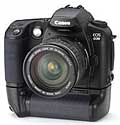 The good folks over at Steve's Digicams have just posted their review of Canon's EOS D30 digital SLR. Here's what Steve has to say: The good folks over at Steve's Digicams have just posted their review of Canon's EOS D30 digital SLR. Here's what Steve has to say:"I'm still going to be updating this conclusion text over the next week or so but rest assured that I am very positive about this camera. With the D30 now showing up (in limited quantity) at the dealers I felt the need to get as much of this information out to the buying public as quickly as possible. I really don't like concluding a review of a camera this feature-rich after having only used it for just a week. If it gives you an idea of how much I like the D30, I will probably be buying one for myself shortly."  Meanwhile, our friends over at the Digital Outback Photo website have commenced their user review of the Kodak DCS 660 digital camera. Thus far, they have two sample photos with more to come as they get to grips with the camera... Meanwhile, our friends over at the Digital Outback Photo website have commenced their user review of the Kodak DCS 660 digital camera. Thus far, they have two sample photos with more to come as they get to grips with the camera...
Be sure to check out both reviews again in a few days to see what further impressions have been added - both cameras are significantly more complex than most consumer models and hence will take Steve and Uwe some time to get a final feeling on...

Friday, October 27, 2000
Olympus demonstrate digicam remote control - by mobile phone!
By Michael Tomkins, The Imaging Resource
(Friday, October 27, 2000 - 16:00 EDT)
 According to a news item from Nikkei Business Publications' AsiaBizTech, digital camera manufacturer Olympus Optical Co. Ltd. has demonstrated an interesting extension on the theme of digital camera remote controls at the World PC Expo 2000 in Tokyo. The remote control operates via an i-mode or other internet-capable mobile phone! According to a news item from Nikkei Business Publications' AsiaBizTech, digital camera manufacturer Olympus Optical Co. Ltd. has demonstrated an interesting extension on the theme of digital camera remote controls at the World PC Expo 2000 in Tokyo. The remote control operates via an i-mode or other internet-capable mobile phone!
 Olympus' system, currently just a prototype to demonstrate the concept, consists of a digital camera (it looks like the Camedia C-21 to us) linked to an Internet-connected image server running software that can be triggered over the 'Net to have the camera capture an image and transfer it to the server. The camera and image server themselves can be located separately and connected by a LAN, ISDN line, or even another mobile phone link. The user accesses the image server via their cell-phone, and gives it the command to capture an image, at which point the server requests an image from the digital camera, receives it and resizes it to a size/quality appropriate for the phone. The image is then sent to the phone for viewing. Olympus' system, currently just a prototype to demonstrate the concept, consists of a digital camera (it looks like the Camedia C-21 to us) linked to an Internet-connected image server running software that can be triggered over the 'Net to have the camera capture an image and transfer it to the server. The camera and image server themselves can be located separately and connected by a LAN, ISDN line, or even another mobile phone link. The user accesses the image server via their cell-phone, and gives it the command to capture an image, at which point the server requests an image from the digital camera, receives it and resizes it to a size/quality appropriate for the phone. The image is then sent to the phone for viewing.
According to the AsiaBizTech item, it takes 20 seconds for the process on an i-mode PHS phone. We're hoping their figures for a non-PHS phone are a mistake though; 60 minutes doesn't sound wildly useable and we're guessing they meant 60 seconds... ;) Two photos of the setup can be seen here.
Source: Nikkei Business Publications' AsiaBizTech

MGI announces new 'immersive' products!
By Michael Tomkins, The Imaging Resource
(Friday, October 27, 2000 - 14:19 EDT)
 MGI Software Corp. has announced two new immersive imaging tools, MGI Photovista 3D Objects and MGI Photovista Virtual Tour, and the launch of 'MGI Web Tools', a developers' site for authoring immersive content using MGI's Photovista family of tools. The new tools and Web site are, says the company, a part of its overall effort to create immersive imaging tools that "are easy-to- use, work with off-the- shelf digital cameras and integrate with Macromedia Web authoring products". MGI Software Corp. has announced two new immersive imaging tools, MGI Photovista 3D Objects and MGI Photovista Virtual Tour, and the launch of 'MGI Web Tools', a developers' site for authoring immersive content using MGI's Photovista family of tools. The new tools and Web site are, says the company, a part of its overall effort to create immersive imaging tools that "are easy-to- use, work with off-the- shelf digital cameras and integrate with Macromedia Web authoring products".
Photovista 3D Objects stitches together a series of still images taken at various points around an object to create a three-dimensional 'image object' of the item. Developers can use any off-the-shelf digital camera to take pictures of an object, by placing the object on a turntable. The resulting image object can then be posted on the Web, enabling visitors to click on and rotate the object to see all the vantage points, simulating the experience of holding and examining a real object. Used in conjunction with MGI ZOOM Image Server, site visitors can zoom into image objects to view fine details. An example of a product demonstration using Photovista 3D Object can be seen in a Sony Japan web page (click the link above, then the graphical button in the lower right corner of the page on which you can see the word "ZOOM").
The second immersive imaging product announced by the company is MGI Photovista Virtual Tour, which includes both MGI Photovista 2.0 and MGI Photovista 3D Objects, plus a virtual tour maker component, which allows the developer to link panoramas with "hotspots" - areas where a viewer can click to jump to other panoramas or image objects. Again, through integration with MGI ZOOM Image Server, virtual tours can be enhanced with high-resolution detail. An example of a high-resolution virtual tour using MGI's Web tools was created depicting Oracle's campus headquarters based in Redwood City, California, and can be seen on Oracle's website."The launch of Photovista 3D Objects, Photovista Virtual Tour and the Web Tools site to compliment the Photovista family of tools is another step in MGI's goal to make 'immersive' images commonplace on the Web," said Andrew Jackson, MGI vice president e-Commerce Imaging and Corporate Marketing. "We look forward to Web developers and interested parties coming to the site to showcase, share and learn about 'immersive' content, drawing the interest of the greater Web community." Both MGI Photovista 3D Objects and MGI Photovista Virtual Tour will be available for online purchase and download from the MGI Web Tools site in the next 45 days.
Source: Yahoo! Finance / PR Newswire

Thursday, October 26, 2000
DCRP posts Panasonic PV-SD5000 PalmCam review!
By Michael Tomkins, The Imaging Resource
(Thursday, October 26, 2000 - 18:02 EDT)
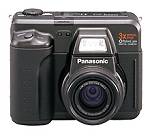 Our friend Jeff over at the Digital Camera Resource Page has just posted his review of Panasonic's PalmCam PV-SD5000 digital camera... What did he think? We'll let him tell you in his own words: Our friend Jeff over at the Digital Camera Resource Page has just posted his review of Panasonic's PalmCam PV-SD5000 digital camera... What did he think? We'll let him tell you in his own words:"The Panasonic PalmCam PV-SD5000 is a camera with a lot of promise when you look at the specs. But unfortunately, it doesn't deliver on those promises. The slow processing speeds, clunky interface, and poor photo quality leads me to believe this is a camera you should steer clear of. For the whopping price of $1099, you can do much better with [another camera]." For the full story and sample pictures, check out the full review.
Source: DCRP's Panasonic PV-SD5000 review

IDC sees 50% compound annual growth for flash market!
By Michael Tomkins, The Imaging Resource
(Thursday, October 26, 2000 - 14:25 EDT)
 The increasing availability and distribution of music over the Internet, the increasing digital camera market, and Internet ubiquity will fuel the fire left behind by the flash memory card market explosion, says International Data Corp. (IDC) The market research company predicts that the flash card market's dramatic 160% shipment growth in 1999 will spur revenue growth, and hence worldwide revenue will increase at a compound annual growth rate of nearly 50%, from $717 million in 1999 to $5.3 billion in 2004. The increasing availability and distribution of music over the Internet, the increasing digital camera market, and Internet ubiquity will fuel the fire left behind by the flash memory card market explosion, says International Data Corp. (IDC) The market research company predicts that the flash card market's dramatic 160% shipment growth in 1999 will spur revenue growth, and hence worldwide revenue will increase at a compound annual growth rate of nearly 50%, from $717 million in 1999 to $5.3 billion in 2004."Faster communication technologies coupled with increasing affordability will bolster the flash card market," said Xavier Pucel, manager for IDC's Semiconductor research program. "Users needing a way to store, archive, transport, and easily transfer content from the Web will drive flash card volume, which in turn will reduce costs." IDC says CompactFlash and SmartMedia will continue to dominate the digital camera market, while other smaller form factors will benefit most from the explosion of mobile applications.
According to the press release, industrial and telecom applications will continue to drive demand for high-end cards, and mainstream digital cameras will fuel demand for low-cost, consumer-oriented removable cards. Additionally, the emergence of digital music players will create demand for additional cards."The trend toward the Internet will not only bring Internet access to PC peripherals like digital cameras, music players, and handhelds, but will also drive new applications and products," Pucel said. "As products connect to the Internet independently of the PC, the market will expand to non-PC owners, driving demand for removable storage." Despite the current flash chip shortage today and the fact that competing companies are striving to develop solutions that are cheaper than flash technology, IDC feels that the outlook for the market is strong and predicts that the window of opportunity for emerging technologies is narrowing.
Source: Yahoo! Finance / PR Newswire

HP PhotoSmart C315 uses Texas Instruments DSP!
By Michael Tomkins, The Imaging Resource
(Thursday, October 26, 2000 - 14:14 EDT)
 Texas Instruments Inc. has announced that the HP PhotoSmart 315 is one of the first digital cameras to employ its fully programmable digital signal processor. TI's DSP image processor, says the company, "plays a major role in the digital camera's unprecedented ability to deliver 2.1-megapixel resolution, a 2.5x digital zoom and a wide array of features for an estimated U.S. street price of $299". Texas Instruments Inc. has announced that the HP PhotoSmart 315 is one of the first digital cameras to employ its fully programmable digital signal processor. TI's DSP image processor, says the company, "plays a major role in the digital camera's unprecedented ability to deliver 2.1-megapixel resolution, a 2.5x digital zoom and a wide array of features for an estimated U.S. street price of $299"."The programmability and processing power of TI DSPs are immense contributors to the price/performance benchmark we're setting with the HP PhotoSmart 315 digital camera," said Dean Anderson, research and development program manager at Hewlett-Packard Company. "This camera delivers 2.1-megapixel resolution at a substantially lower price than its competitors, its shot-to-shot delay is dramatically reduced, and image preview on its 1.8-inch color LCD is faster at high resolutions." Early digital cameras required internal 'buffer' memory to store captured images, the press release continues to note. Once this memory was full, another shot could not be taken until the stored image processing was complete. The improvement in performance afforded by TI's digital imaging chip, the TMS320DSC21, is claimed to reduce processing time and hence the need for expensive internal memory, resulting in a faster recycle time at a lower cost to consumers."This fully programmable, high-performance DSP solution from Texas Instruments enables our customers to produce photo-realistic images by implementing the latest advances in image processing in DSP software," said Dr. Raj Talluri, chief executive officer of the Digital Still Camera Business Unit at Texas Instruments. "The programmability of the DSC21 also translates to significant reductions in development time and costs for our customers." 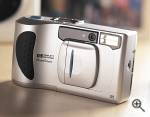 The performance and price of the HP PhotoSmart 315 digital camera are, say Texas Instruments, compelling incentives for consumers to experience digital photography for the first time; the company notes that HP's PhotoSmart 315 digital camera provides "twice the image resolution of other cameras at this price range". TI's DSC21 enables features such as USB connectivity, CompactFlash storage, and an HP JetSend infrared interface for wireless printing. Other features include automatic red-eye reduction, a flash with a 3-meter range and a six-element glass lens. The performance and price of the HP PhotoSmart 315 digital camera are, say Texas Instruments, compelling incentives for consumers to experience digital photography for the first time; the company notes that HP's PhotoSmart 315 digital camera provides "twice the image resolution of other cameras at this price range". TI's DSC21 enables features such as USB connectivity, CompactFlash storage, and an HP JetSend infrared interface for wireless printing. Other features include automatic red-eye reduction, a flash with a 3-meter range and a six-element glass lens.
The DSC21 is, says TI, "the industry's first fully programmable DSP-based processor designed exclusively for the unique challenges of digital imaging applications". It is a single-chip processing engine for digital still cameras that combines a TMS320C5000 DSP and an ARM7TDMI RISC processor for media processing and system control functions. It also integrates a video encoder with on-screen display, SDRAM controller with a bandwidth transfer rate of 320 Mb/second, and a preview engine that performs 30 frame-per-second NTSC and PAL previewing. The DSC21 enables real-time frame capture in burst mode to the full resolution of a 2-megapixel image sensor.
In addition to capturing high-resolution still photos with a short shot-to-shot delay, digital cameras that employ the DSC21 can be programmed with the ability to record video clips with audio and play Internet audio files. The chip also supports popular digital audio and video formats including real-time MPEG1, MPEG4, JPEG, MJPEG, H.263 and MP3, as well as data communication standards such as IrDA, USB, and RS-232.
Source: Yahoo! Finance / PR Newswire

PhotoWorks allies with American Greetings!
By Michael Tomkins, The Imaging Resource
(Thursday, October 26, 2000 - 13:46 EDT)
 PhotoWorks has announced the signing of an agreement with online greetings site AmericanGreetings.com to develop co-branded services including an American Greetings photo-sharing site, and personalized PhotoWorks electronic greetings cards. The new services are expected to launch in December. PhotoWorks has announced the signing of an agreement with online greetings site AmericanGreetings.com to develop co-branded services including an American Greetings photo-sharing site, and personalized PhotoWorks electronic greetings cards. The new services are expected to launch in December."PhotoWorks and AmericanGreetings.com are experts in delivering highly personalized experiences on the Internet, and working with AmericanGreetings.com is a positive development for our service. This brings together two categories -- online greetings and digital photography -- that have seen immense growth in users," said Gary Christophersen, PhotoWorks President and CEO. "Now consumers will be able to easily include their most recent vacation pictures, photographs of their kids in Halloween costumes, or any favorite snapshots from their PhotoWorks archive in the electronic greetings."  AmericanGreetings.com customers will be able to view, store and share their own images online via a co-branded private storage area. Through the co-branded site, AmericanGreetings.com customers will also have access to PhotoWorks products and services such as film and digital image processing, and the fulfillment of orders for reprints and photo merchandise. AmericanGreetings.com customers will be able to view, store and share their own images online via a co-branded private storage area. Through the co-branded site, AmericanGreetings.com customers will also have access to PhotoWorks products and services such as film and digital image processing, and the fulfillment of orders for reprints and photo merchandise.
Through strategically placed links on the PhotoWorks site, customers will be able to access AmericanGreeting.com's online superstore of creative content, giving them the ability to customize electronic greetings with photographs from their archive and create distinctive messages for family and friends.
Source: Yahoo! Finance / Business Wire

EOS Systems announces PhotoModeler Pro 4.0!
By Michael Tomkins, The Imaging Resource
(Thursday, October 26, 2000 - 11:50 EDT)
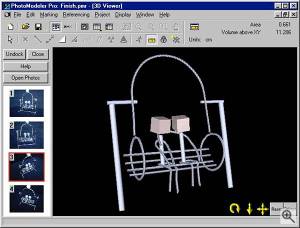
Vancouver-based Eos Systems Inc. has announced the release of PhotoModeler Pro 4.0, the latest version of its software program that uses photographs to build 3D models and measurements. PhotoModeler Pro 4.0 adds numerous new features and improvements, which the company says make it "a very powerful modeling and measuring software package". PhotoModeler Pro 4.0 sells for $795 US. Current customers are entitled to special upgrade pricing as low as $395US.
The new release includes many features which EOS feels were previously only available in expensive high-end packages, such as Curves (full NURBS curves), Edges, Constraints, new Surfacing Functions, improved Single Photo Project capabilities, Enhanced Referencing, Projections, Field Camera Calibration, Automated Referencing functions, and more. The new features are in addition to the standard features of PhotoModeler Pro, which include automatic camera orientation, surface drawing, enhanced file export, enhanced photo-texturing, cylinder modeling, and multimedia tutorials."PhotoModeler Pro 4.0 is a major release for both new and existing customers," says Alan Walford, President of Eos Systems. "PhotoModeler Pro 4.0 contains many advanced features that were developed based on customer wishes. In addition, existing features have been enhanced and improved to make PhotoModeler even more accurate, efficient and easy to use." PhotoModeler Pro is used worldwide for applications including 3D animation, architecture, accident reconstruction, forensics, archaeology, engineering, piping, surveying, and webpage design. For example, animators can use photographs and PhotoModeler Pro to model existing objects complete with realistic phototextures.
Source: EOS Systems' PhotoModeler Pro 4.0 press release

Digital Outback posts EOS D30 user review!
By Michael Tomkins, The Imaging Resource
(Thursday, October 26, 2000 - 11:10 EDT)
Our friend Uwe over at the Digital Outback Photo website has made a number of additions worth noting over the last few days. First up, Uwe has commenced his own user review of Canon's EOS D30 digital SLR camera. He's also posted an article called "The 'Art' of CRW conversion", which looks at the process of converting Canon's proprietary CCD-RAW files, an index of known digital SLR reviews on the web, an extra sample on his perspective correction page, and a photo story on the 'Hunderwasser House', an interesting Viennese apartment building that is a living artwork...

Wednesday, October 25, 2000
Luminous Landscape posts EOS D30 review!
By Michael Tomkins, The Imaging Resource
(Wednesday, October 25, 2000 - 15:39 EDT)
 We noted today a reference in a news item over at the Digital Photography Review which led us to the Luminous Landscape website, run by photographer Michael H. Reichmann. Michael is amongst the first to have purchased and received a Canon EOS D30 digital camera, and has posted a review of his initial impressions, as well as a comparison of CCD-RAW and JPEG files, and a comparison which will undoubtedly spark controversy and debate by its finding that the image quality of the D30 is, for most purposes, better than film... Interesting stuff! We noted today a reference in a news item over at the Digital Photography Review which led us to the Luminous Landscape website, run by photographer Michael H. Reichmann. Michael is amongst the first to have purchased and received a Canon EOS D30 digital camera, and has posted a review of his initial impressions, as well as a comparison of CCD-RAW and JPEG files, and a comparison which will undoubtedly spark controversy and debate by its finding that the image quality of the D30 is, for most purposes, better than film... Interesting stuff!
Source: Luminous Landscape's Canon EOS D30 review

PCPhotoReview announces digicam database, new contests!
By Michael Tomkins, The Imaging Resource
(Wednesday, October 25, 2000 - 13:44 EDT)
 Our friends over at the PCPhotoReview website have been in touch to let us know of some interesting developments for their readers... First up, they've added a new comparison database with 47 current and 86 discontinued digital cameras. You can compare specifications for up to 5 of either the current or discontinued cameras side by side. Our friends over at the PCPhotoReview website have been in touch to let us know of some interesting developments for their readers... First up, they've added a new comparison database with 47 current and 86 discontinued digital cameras. You can compare specifications for up to 5 of either the current or discontinued cameras side by side.
The site has also just started up two new contests for readers. In the first, you can receive one contest entry for each review or sample photo you submit, with prizes including an Olympus C-3000 Zoom digital camera, JASC Paint Shop Pro 7, and Microsoft PictureIt! 2000. The second contest is offering a 1-year subscription to PCPhoto magazine to the creator of the funniest caption to a truly bizarre photo selected by the PCPhotoReview team... ;)

3DGameMan posts Kodak DC3400 video review!
By Michael Tomkins, The Imaging Resource
(Wednesday, October 25, 2000 - 13:12 EDT)
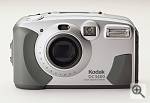 An email from the folks at the 3DGameMan website led us to their review of Kodak's DC3400 digital camera today. 3DGameMan have an interesting concept, in that their review is actually a video in Microsoft's "Advanced Streaming Format" (ASF), which can be played back with Microsoft's Media Player 6 or higher on either a PC or Macintosh computer. An email from the folks at the 3DGameMan website led us to their review of Kodak's DC3400 digital camera today. 3DGameMan have an interesting concept, in that their review is actually a video in Microsoft's "Advanced Streaming Format" (ASF), which can be played back with Microsoft's Media Player 6 or higher on either a PC or Macintosh computer.
The video file is a weighty 8MB in size, which shouldn't be a problem on a high-speed Internet connection, but if you're still on a dial-up connection, it would probably be easiest to just download the whole file in one go. 3DGameMan makes a point that the review is unedited, which means that since the reviewer is also the camera-man, you get a pretty good idea whether it is possible to open that CompactFlash door single-handed... ;) The review is listed under the heading for October 23, 2000, and is accompanied by 19 sample images from the camera. When you're done, get a second and third opinion from our own review, and that from the Digital Camera Resource Page!
Source: 3DGameMan's Review index

Tuesday, October 24, 2000
ArcSoft brings Panorama Maker, Photo Printer to the Mac!
By Michael Tomkins, The Imaging Resource
(Tuesday, October 24, 2000 - 19:13 EDT)
 Software company ArcSoft Inc. today announced that it has ported two of its photo-enhancing programs, Panorama Maker and PhotoPrinter Pro, to the Macintosh platform. Previously available to PC users, the new software offerings extend Arcsoft's editing, enhancing and panoramic capabilities to the Mac platform. Both Panorama Maker and PhotoPrinter Pro are being offered separately at a suggested retail price of $29.99 and will ship in November. Software company ArcSoft Inc. today announced that it has ported two of its photo-enhancing programs, Panorama Maker and PhotoPrinter Pro, to the Macintosh platform. Previously available to PC users, the new software offerings extend Arcsoft's editing, enhancing and panoramic capabilities to the Mac platform. Both Panorama Maker and PhotoPrinter Pro are being offered separately at a suggested retail price of $29.99 and will ship in November."ArcSoft understands and appreciates Apple's commitment to developing an intuitive, creative atmosphere for computer users," said Todd Rumaner, Vice President of Marketing and Business Development at ArcSoft. "We hope to expand the user's experience of the Mac platform through ArcSoft's easy-to-use, yet technologically comprehensive imaging programs for the Mac-enthusiast. PhotoPrinter Pro and Panorama Maker offer both the novice and the more experienced photographer the best tools available to get the most out of their digital images."  Panorama Maker helps people create panoramic images out of their photos with options such as Horizontal Panoramas, Vertical Panoramas, Tile-style Panoramas or 360-degree Panoramas. Key features include the ability to stitch together photos and a special, surround-view option that helps users fully display 360-degree panoramas. Claimed to be faster and more accurate than similar products, Panorama Maker offers Mac users clean, realistic results, the company says. The program's user interface follows a storyboard design that includes multi-page and banner printing options as well as custom paper size settings. Panorama Maker helps people create panoramic images out of their photos with options such as Horizontal Panoramas, Vertical Panoramas, Tile-style Panoramas or 360-degree Panoramas. Key features include the ability to stitch together photos and a special, surround-view option that helps users fully display 360-degree panoramas. Claimed to be faster and more accurate than similar products, Panorama Maker offers Mac users clean, realistic results, the company says. The program's user interface follows a storyboard design that includes multi-page and banner printing options as well as custom paper size settings.
 PhotoPrinter Pro offers a range of printing features for the photo-enthusiasts that lets users format their multiple images in a variety of sizes on a single sheet of paper, including a customization option. With a variety of font styles, colors and sizes, even amateur photo-editors will be able to create interactive photos and album, the press release notes. Other PhotoPrinter features include the Edit Template, Freestyle Layout, Printing Support and Special Effects and Editing tools. Using these options, users can drag and drop photos into custom photo templates, supplied frames, borders, backgrounds and masking. They then have the option of moving photos into any desired position and printing their creations. The program's editing tools allow users to crop, rotate, cut, paste, copy, adjust size, color or brightness of each photo. In addition, users can user the application's easy-to-use special effect filters to paint, sketch or add mosaic elements to their favorite photographs. PhotoPrinter Pro offers a range of printing features for the photo-enthusiasts that lets users format their multiple images in a variety of sizes on a single sheet of paper, including a customization option. With a variety of font styles, colors and sizes, even amateur photo-editors will be able to create interactive photos and album, the press release notes. Other PhotoPrinter features include the Edit Template, Freestyle Layout, Printing Support and Special Effects and Editing tools. Using these options, users can drag and drop photos into custom photo templates, supplied frames, borders, backgrounds and masking. They then have the option of moving photos into any desired position and printing their creations. The program's editing tools allow users to crop, rotate, cut, paste, copy, adjust size, color or brightness of each photo. In addition, users can user the application's easy-to-use special effect filters to paint, sketch or add mosaic elements to their favorite photographs.
Source: Yahoo! Finance / Business Wire

40% of students hoping for digicam this Christmas!
By Michael Tomkins, The Imaging Resource
(Tuesday, October 24, 2000 - 16:46 EDT)
 In a recent survey conducted by online store edu.com, college students identified digital cameras, CD burners and MP3 players as their most desired high-tech gadgets this holiday season. In a recent survey conducted by online store edu.com, college students identified digital cameras, CD burners and MP3 players as their most desired high-tech gadgets this holiday season.
The company surveyed more than 7,800 verified, enrolled college students to determine which high-tech products they most desired and would like to receive as a gift this holiday season. Of those students who responded, 40 percent said they wanted a digital camera; 34 percent said a CD burner and 23 percent specified an MP3 player. The survey further revealed that 75 percent of students prefer hand held digital cameras to Web cams.
While anyone can visit www.edu.com, only verified, enrolled college students can take advantage of discounts offered at the site. Students can receive discounts on brand name school essentials including computers, software, textbooks, bank services, phone and Internet services and more. In addition, the site offers savings on electronics popular among college students including MP3 players, digital cameras, scanners, CD burners, interactive games and more."edu.com is the only online company to serve, and have the ability to poll, a 100 percent verified student-only audience," says Don LeBlanc, vice president of Customer Insight at edu.com. "At edu.com we verify each customer who registers to ensure that he/she is indeed a college student and deserving of the big discounts we have negotiated on their behalf. Limiting our audience to college students and continually querying their interests, enables edu.com to accurately determine what products and services they need and value most."
Source: Yahoo! Finance / PR Newswire

Survey finds film usage falls after digicam purchase!
By Michael Tomkins, The Imaging Resource
(Tuesday, October 24, 2000 - 16:29 EDT)
 A new Lyra Research Inc. study conducted in Japan among digital camera users indicates that use of these new devices leads to reduced use of conventional cameras and film in the majority of instances. A presentation of the full results of this study is planned to be one of the highlights of this week's Digital Photography Conference, jointly hosted by Lyra and JDS Company Limited, in Tokyo on October 25. A new Lyra Research Inc. study conducted in Japan among digital camera users indicates that use of these new devices leads to reduced use of conventional cameras and film in the majority of instances. A presentation of the full results of this study is planned to be one of the highlights of this week's Digital Photography Conference, jointly hosted by Lyra and JDS Company Limited, in Tokyo on October 25.
In the Web-based survey of more than 2,600 qualified home users of digital cameras, conducted in August on the Japan-based Hi-Ho site, more than 60 percent of the respondents said they are using film cameras less since acquiring digital units. The survey also found that about 35 percent of digital camera owners said that that their use of conventional cameras and film remained about the same, while about 5 percent reported more frequent use of conventional cameras and film. The survey questionnaire screened for people who have used a digital camera to take home or personal pictures for at least six months and who have also owned a film camera."The changes in usage behavior indicated by this study are pretty dramatic," comments Ed Lee, director of Lyra's Digital Photography Advisory Service. "This is a trend that bears further monitoring and longitudinal research. If the trend continues, it could spell very bad news for film manufacturers." The survey further points to a direct and significant reduction in silver-halide film use after the usage of a digital camera begins. On average, respondents reported film usage of more than seven rolls in the six-month period prior to beginning to use a digital camera. In the six months since beginning to use a digital camera, these same users reported that their film usage dropped by about two rolls - a 27 percent decrease in usage.
Source: Yahoo! Finance / Business Wire

Kodak's DC280 offered as prize in ememories, GenerationA contest!
By Michael Tomkins, The Imaging Resource
(Tuesday, October 24, 2000 - 16:20 EDT)
Online photo-sharing site ememories.com has announced a partnership with GenerationA.com, an online community for Americans over the age of 50, bringing wired seniors access to photo sharing and online photo processing services.In order to promote the new partnership, the two companies will give away one Kodak DC280 Digital Camera to each winner of the 'GenerationA Grandchild of the Month Photo Contest'."The 50+ crowd is the fastest growing demographic on the Web," said Brian Acrish, Co-founder of GenerationA.com. "Ememories.com's on-line photo albums, processing and personalized merchandise are perfect for this emerging group. This partnership is a major step in fulfilling our mission to introduce our members to the many benefits of the Internet." Online growth among baby boomers and seniors represents 18.4% of the Internet's overall growth, making them the fastest growing Internet population, according to Media Metrix. Both ememories and GenerationA believe this emerging group of Internet users will adopt online photo sharing and processing."We are constantly looking for new ways to bring ememories.com services to new groups," said Tim Kilpin, CEO of ememories.com. "The goal for the partnership with GenerationA.com is to position us as the premier source of online photo services for Americans 50+."
Source: Yahoo! Finance / PR Newswire

Glue and CDs don't mix! Sony/PC Photo woes...
By David Etchells, The Imaging Resource
(Tuesday, October 24, 2000 - 13:49 EDT)
It sounds like this is a widely enough experienced problem that it's worth mentioning here. (Judging by the number of emails I've gotten on the subject.)
Sony recently mounted what must have been an enormously expensive marketing campaign, with 3" CD-ROMs bound into every issue of PC Photo magazine. The idea (I guess) was to let people see for themselves how useful a 3" CD could be. Unfortunately, through no fault of Sony's, the campaign seems to have massively backfired: PC Photo apparently used some sort of a gluey substance to affix the CDs to the magazine page that left a residue on the CD surface. (Or that otherwise damaged the CD, rendering it unusable.) The net effect was to convince thousands of digicam enthusiasts that those funny little 3" CDs really didn't work in their computers after all. Yikes! Having tracked the problem down to the glue, PC Photo is preparing a large quantity of replacement disks for interested readers who might like to see what was actually on the original. Presumably, they'll be publishing instructions on how to obtain one of these replacement disks in their next issue. Meanwhile, we thought to post this note here, so people wouldn't wrongly conclude that the 3" disks weren't compatible with their computers: The 3" (77mm) size was actually part of the original CD-ROM spec, and the vast majority of computers will support it just fine. Stay tuned for more from Sony and PC Photo on this, ut in the meantime rest easy that odds are your computer will read (non-glue-coated) CD-ROMs just fine...

Mike's out, Dave's pinch-hitting
By David Etchells, The Imaging Resource
(Tuesday, October 24, 2000 - 13:39 EDT)
In what sounds like a remarkably un-funny comedy of errors, Comcast has managed to well and truly foul up News Editor Mike Tomkin's internet connection: First the cable modem went dead, then once that was up (a full day and a half later), Comcast's DHCP server crashed. Bottom line, Mike's about to scrounge a backup dialup connection, and Dave's going to pinch-hit a bit today. Hence likely a little spotty on news today, as the sun and sky is right for getting some of our outdoor test shots done with the ever-present pile of digicams. Stay tuned though, a couple of interesting items coming in a bit...

Monday, October 23, 2000
Agfa ePhoto CL30 owners take note - AC adapter recalled!
By Michael Tomkins, The Imaging Resource
(Monday, October 23, 2000 - 12:09 EDT)
 Agfa has today announced that it is conducting a recall on the optional ePhoto AC-adapters that were supplied as an accessory to the AGFA ePhoto CL30 digital camera. When the AC adapter is used at the same time as batteries are in the camera, it may cause the batteries to overheat, leak acid and possibly explode, the company says. Agfa has today announced that it is conducting a recall on the optional ePhoto AC-adapters that were supplied as an accessory to the AGFA ePhoto CL30 digital camera. When the AC adapter is used at the same time as batteries are in the camera, it may cause the batteries to overheat, leak acid and possibly explode, the company says.
 The AGFA ePhoto CL30 digital camera is not being recalled, and may continue to be used without concern as long as you do not use the recalled ePhoto AC-adapter WHILE batteries are installed in the camera. If you have an Agfa ePhoto CL30 camera with the optional accessory ePhoto AC-adapter, your AC-adapter will be replaced at no cost. Customers are requested to contact the local Agfa service organisations for further details. The AGFA ePhoto CL30 digital camera is not being recalled, and may continue to be used without concern as long as you do not use the recalled ePhoto AC-adapter WHILE batteries are installed in the camera. If you have an Agfa ePhoto CL30 camera with the optional accessory ePhoto AC-adapter, your AC-adapter will be replaced at no cost. Customers are requested to contact the local Agfa service organisations for further details.
The AC adapters used for the 'Agfa ePhoto CL 30 clik!' digital camera are not subject to the recall.
Source: Agfa's ePhoto CL30 recall info

DCRP posts Canon PowerShot G1 review!
By Michael Tomkins, The Imaging Resource
(Monday, October 23, 2000 - 11:22 EDT)
 Our friend Jeff over at the Digital Camera Resource Page has now posted his review of Canon's PowerShot G1 digital camera. Jeff notes: Our friend Jeff over at the Digital Camera Resource Page has now posted his review of Canon's PowerShot G1 digital camera. Jeff notes:"[The] PowerShot G1 takes care of a lot of issues that I had with the Coolpix 990, such as sound with movies, CompactFlash Type II support, and a hot shoe. Plus it adds the very handy swiveling LCD! This one would definitely be one of the finalists if I was camera shopping, and its very much worth your time to consider it!" Be sure to check out the full review which contains images of the camera itself, sample photos and much more...
Source: DCRP's Canon PowerShot G1 review

Thursday, October 19, 2000
Snapfish allies with Delta Express!
By Michael Tomkins, The Imaging Resource
(Thursday, October 19, 2000 - 2:18 EDT)
 Online photofinisher Snapfish has announced a parternship with Delta Express, the low-fare carrier of Delta Air Lines. Initially, the companies will work together to offer Delta Express passengers leaving Orlando, Florida access to Snapfish's free 35 mm film processing services to develop their vacation photos. Online photofinisher Snapfish has announced a parternship with Delta Express, the low-fare carrier of Delta Air Lines. Initially, the companies will work together to offer Delta Express passengers leaving Orlando, Florida access to Snapfish's free 35 mm film processing services to develop their vacation photos.
The partnership is, says the press release, "part of Snapfish's larger 'Point-of-Picture' strategy, [designed] to leverage offline partners to offer its free film processing, digitizing and sharing services, the strategy makes free postage-paid film mailers available wherever families are taking pictures."
 The first initiative of the partnership will begin in November 2000. Delta Express flights departing from Orlando will offer passengers free Delta-Snapfish co-branded film mailers. The mailers are free postage-paid envelopes through which consumers can register for the Snapfish service and mail in their 35 mm film from their vacation. After making an announcement on the plane's public address system, flight attendants will distribute the mailers to passengers. Families drop in the film from their vacation, fill out the envelope and put it in the mail. The first initiative of the partnership will begin in November 2000. Delta Express flights departing from Orlando will offer passengers free Delta-Snapfish co-branded film mailers. The mailers are free postage-paid envelopes through which consumers can register for the Snapfish service and mail in their 35 mm film from their vacation. After making an announcement on the plane's public address system, flight attendants will distribute the mailers to passengers. Families drop in the film from their vacation, fill out the envelope and put it in the mail."The success of Snapfish's unique 'Point-of-Picture' strategy depends on building a network of great partners with similar customer bases, and allowing those partners to offer our value proposition to their customers," said Raj Kapoor, CEO and co-founder of Snapfish. "As the first online photo processor to partner with an airline like Delta Express, Snapfish affirms its position as the fastest growing, most innovative company in the space."
"Delta Express is committed to offering its customers value," said Carmine Testa, General Manager-Delta Express. "Our partnership with Snapfish enables us to offer price-conscious travelers a way to save money on film processing in addition to saving money with our low fares." The relationship builds upon Snapfish's marketing strategy to reach consumers offline. Other offline components include a print advertising campaign that ran in the July 2000 issue of Delta's Sky magazine. The ads contain a pullout Snapfish mailer placed adjacent to the print advertisement.
Source: Yahoo! Finance / PR Newswire

Wednesday, October 18, 2000
Fuji ships the FinePix 4900Z!
By Michael Tomkins, The Imaging Resource
(Wednesday, October 18, 2000 - 14:53 EDT)
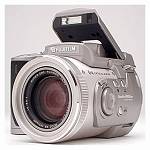 Fuji Photo Film U.S.A. Inc. has announced that it has begun shipping the FinePix 4900 ZOOM, a digital camera which we reviewed recently here at the Imaging Resource. Fuji Photo Film U.S.A. Inc. has announced that it has begun shipping the FinePix 4900 ZOOM, a digital camera which we reviewed recently here at the Imaging Resource. "With its new design and functionality, the FinePix 4900 ZOOM represents a significant addition to Fujifilm's line of digital cameras, building upon the legacy started by the MX-2900," said Darin Pepple, Product Manager, Consumer Digital Products, Fuji Photo Film U.S.A., Inc. "By taking the most popular aspects of the MX-2900 and adding a number of new features such as Super CCD, the FinePix 4900 ZOOM should garner a lot of attention among photographers. Also, those looking to post clear Web photos or create nice, sharp prints will be pleased with this camera." The Fuji FinePix 4900 Zoom digital camera carries a suggested street price of $999.
Source: Yahoo! Finance / Business Wire

Polaroid announces third quarter results!
By Michael Tomkins, The Imaging Resource
(Wednesday, October 18, 2000 - 14:17 EDT)
 Polaroid Corp.'s digital strategy "presents a major opportunity to grow the company's sales and profits over the next several years", says Gary T. DiCamillo, company chairman and chief executive officer. DiCamillo delivered the message in a conference call to the investment community following the release of the company's third quarter earnings. Polaroid posted net income of $18 million and an operating profit of $49 million on sales of $458 million for the quarter. Polaroid Corp.'s digital strategy "presents a major opportunity to grow the company's sales and profits over the next several years", says Gary T. DiCamillo, company chairman and chief executive officer. DiCamillo delivered the message in a conference call to the investment community following the release of the company's third quarter earnings. Polaroid posted net income of $18 million and an operating profit of $49 million on sales of $458 million for the quarter."Through three quarters, our business is healthy. Sales are up 5% on a comparable basis versus last year and operating profits up 26%. This clearly reflects our success in revitalizing instant camera and film growth and profitability," he said. Polaroid saw more than 30 percent growth in digital sales behind a nearly four-fold increase in digital camera unit sales in the third quarter compared to the same quarter last year. The company continues to hold a category-leading 43 percent share of digital camera volume sold in U.S. Food, Drug and Mass Merchandising stores, according to the latest data from Information Resources Inc.
DiCamillo pointed out that at the beginning of this year digital products were a relatively small product group at Polaroid accounting for less than 10 percent of total sales, but that it could be "15 percent or more of the company's sales by year-end 2001." He noted that although digital products carry lower profit margins than the core Polaroid business, they should produce a revenue increase of "at least 30-to-40 percent next year" with "profitability expected to improve as we begin to realize film burn in our new digital hybrid products."In discussing one of the hybrid products, the Polaroid P-500 Digital Photo Printer, DiCamillo said, "We are very encouraged by early market reception of our digital picture printer - a wireless, instant photo printer that uses the compact flash from any digital camera. It instantly prints Polaroid photos in less than 15 seconds at the touch of a button and is being shipped late this quarter. The explosion of the digital imaging category and early success of Polaroid's digital hybrid products give me reason for excitement next year." DiCamillo believes that digital capture and printing solutions can accelerate Polaroid's digital growth profitability. He said that the company's largest opportunity could be Polaroid's new digital media, which is slated for unveiling sometime in the first half of 2001.
Today's conference call afforded the Polaroid CEO a chance to provide his outlook on the company's fourth quarter, which he believes will show "flattish revenue growth rates," not including foreign exchange and retail inventory reductions. "We are seeing three reasons for caution in the fourth quarter," he said.
DiCamillo cited the Euro as the first reason saying that at today's level it could have a $15 million impact on revenues and a $7 million impact on operating profit in the fourth quarter. He listed the second reason as a "mix shift to our newer film types and away from traditional film lines. This mix shift accounts for our relatively flat dollar sales, despite strong unit sales increases in the third quarter". Finally, he noted that Polaroid was "sensing that major retailers are growing more conservative in their holiday outlook and seem to be trimming inventories".
Source: Yahoo! Finance / PR Newswire

Full Review of Olympus C-2100 UltraZoom posted!
By David Etchells, The Imaging Resource
(Wednesday, October 18, 2000 - 2:57 EDT)
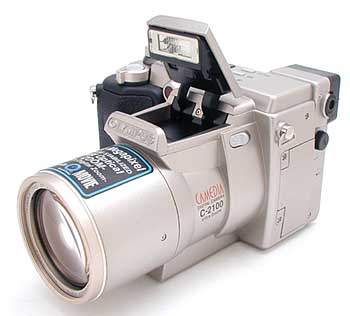
This must be "Olympus Week" - Two reviews in two days of Olympus cameras. Today's is the aptly named C-2100 UltraZoom, with a 10x optical zoom lens, 2 megapixels worth of CCD, an eyelevel viewfinder that we object to on philosophical grounds, but which is actually usable to dimmer levels than we've seen in the past. (Still doesn't go down *nearly* as dark as the camera can take a picture at though, as the 2100 is a superb low-light performer.) Overall, a very interesting camera, great lens, great picture quality, all the exposure-control bells and whistles you could want. Very nice! (We do admit to a bit of a personal long-zoom fetish though.) Read the review for all the details!
Source: IR review of C-2100 UltraZoom

Tuesday, October 17, 2000
Full Review of Olympus E-10 SLR posted!
By David Etchells, The Imaging Resource
(Tuesday, October 17, 2000 - 18:16 EDT)
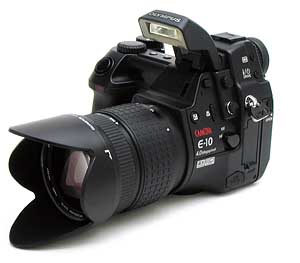 Wow! This is probably one of the most-awaited reviews we've had in a while, so we put some extra effort into extracting a number of technical details on the camera: We had a bit over a week with a preproduction model of it, and were very impressed. This is a very interesting unit, both for its capabilities (a full 4 megapixel CCD, simultaneous optical SLR viewfinder & live LCD viewfinder, excellent exposure controls, and incredible low light capability) and for its price ($1,999 US at introduction). While it doesn't support interchangeable lenses like some other SLR digicams, there are in fact some advantages to that fact. It's 4x optical zoom may be enough for many users, and Olympus has an interesting collection of front-element accessory lenses for it, covering an equivalent focal length range of 28mm to 420mm(!). Finally its $1,999 launch price puts it $1,500 or so below its nearest competitor (the Canon D30), even though the E-10's price includes the cost of the lens. A very interesting unit, and be sure to check out the moonlight pictures we shot with it! Read the review for all the details!
Source: IR Review of E-10 Pro SLR

DPReview posts Fuji FinePix 4900Z review!
By Michael Tomkins, The Imaging Resource
(Tuesday, October 17, 2000 - 16:33 EDT)

Our friends over at the Digital Photography Review have just posted their review of Fujifilm's Finepix 4900Z digital camera. Phil notes:"Fujifilm's 4900Z is a vast improvement over last year's 2900Z, a more advanced design, higher resolution, more manual controls (the majority of which accessable from the outside of the camera). The 4900Z is also surprisingly compact and light (indeed it's light weight may be one of it's greatest assets). The 4900Z is also very fast, with preview mode switched off you can click-click-click the images without any discernible delay, and in continuous mode it produced some of the fastest shooting we've seen this side of a digital SLR (if only for 5 frames)." Whilst Phil's review is apparently of a production camera, our usual recommendations of second opinions do come with a proviso - both our own review, and that from Steve's Digicams are of preproduction cameras... Hence, bear in mind that whilst they're definitely still useful for getting a second opinion, they are not necessarily representative of the image quality available in a production camera.
Source: Digital Photography Review Fuji Finepix 4900Z review

FlashPoint, Red Hen announce MediaMapper 3.0!
By Michael Tomkins, The Imaging Resource
(Tuesday, October 17, 2000 - 15:25 EDT)
FlashPoint Technology Inc., the company behind the Digita operating system used by some digital cameras, has announced the release by Red Hen Systems of a new version of the MediaMapper software we first told you about back on June 28th. The program, developed with FlashPoint's DigitaScript programming language, embeds Global Positioning System positioning data with digital images.
MediaMapper uses a Digita OS enabled Kodak DC290 digital camera and a GPS receiver to embed latitude, longitude and altitude data as each image is captured. The application allows the image and associated metadata to be transferred to a personal computer, where an interactive multimedia map is automatically constructed. Applications include documenting and tracking real estate, construction projects, land management and natural disaster sites. "The flexibility of the Digita scripting environment allows us to store GPS data plus additional information that enables GPS differential post-processing for greatly improved positional accuracy," said Ken Burgess, Vice President of Research and Development at Red Hen Systems. "We can also store information about the camera's direction of view from a digital compass, and range data from a laser rangefinder, along with each image." "The flexibility of the Digita scripting environment allows us to store GPS data plus additional information that enables GPS differential post-processing for greatly improved positional accuracy," said Ken Burgess, Vice President of Research and Development at Red Hen Systems. "We can also store information about the camera's direction of view from a digital compass, and range data from a laser rangefinder, along with each image."
 "The merging of GPS data and digital photography is made possible by the Digita OS," said Stephen Saylor, President of FlashPoint. "The power of Digita is its speed and flexibility. People can tailor applications to meet specific needs, and that includes building solutions for commercial markets." "The merging of GPS data and digital photography is made possible by the Digita OS," said Stephen Saylor, President of FlashPoint. "The power of Digita is its speed and flexibility. People can tailor applications to meet specific needs, and that includes building solutions for commercial markets."
MediaMapper version 3.0, available immediately, is a free upgrade for customers who purchased MediaMapper 2.1 after August 1st, 2000. The new version requires an upgrade of the VMS200 hardware which costs $250.
Source: Yahoo! Finance / Business Wire

Iomega FotoShow ships in the USA!
By Michael Tomkins, The Imaging Resource
(Tuesday, October 17, 2000 - 15:11 EDT)
 Iomega Corp. has announced the domestic release of its latest consumer electronics product, the FotoShow Digital Image Center. Developed with the digital photography enthusiast in mind, FotoShow features built-in PictureIQ software, and is intended to make it easier to organize, edit, and share digital photos with family and friends without the need for a PC. Iomega Corp. has announced the domestic release of its latest consumer electronics product, the FotoShow Digital Image Center. Developed with the digital photography enthusiast in mind, FotoShow features built-in PictureIQ software, and is intended to make it easier to organize, edit, and share digital photos with family and friends without the need for a PC."As with all photography, people want to be able to view their pictures right away, and they want to be able to share them with their family and friends," said Bruce Albertson, president and CEO, Iomega Corporation. "FotoShow makes it easier than ever for them to do that in the comfort of their family room and without the use of a computer. In commercial applications, we also see the FotoShow player as a natural imaging tool for real estate offices and the insurance industry, and we're excited about its prospects in hotels and in other high-traffic tourism settings." 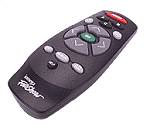 The FotoShow Digital Image Center's PictureIQ software provides photo-editing features via an included remote control. Red-eye removal, one-touch photo fixing, cropping, zooming, image rotation and the addition of artistic templates are among the built-in features, none of which require the complexity and expense of a computer. Digital camera owners can also use the FotoShow image center's built-in CompactFlash and SmartMedia slots for one-button transfer of camera images to the internal Zip 250MB drive, freeing up expensive solid state memory cards for taking more digital pictures. Iomega also offers an optional 12-volt car adaptor for use on the road. The FotoShow Digital Image Center's PictureIQ software provides photo-editing features via an included remote control. Red-eye removal, one-touch photo fixing, cropping, zooming, image rotation and the addition of artistic templates are among the built-in features, none of which require the complexity and expense of a computer. Digital camera owners can also use the FotoShow image center's built-in CompactFlash and SmartMedia slots for one-button transfer of camera images to the internal Zip 250MB drive, freeing up expensive solid state memory cards for taking more digital pictures. Iomega also offers an optional 12-volt car adaptor for use on the road.
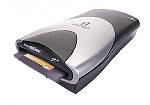 The FotoShow image center connects to a TV through composite video or S-Video ports, or to a USB-equipped computer through the USB port. When connected to a computer, it operates as a normal Zip drive and lets users transfer photos from any source - including the hard drive, scanned pictures, pictures attached to personal e-mails, or those downloaded from the Internet - for later viewing on the television. The FotoShow image center connects to a TV through composite video or S-Video ports, or to a USB-equipped computer through the USB port. When connected to a computer, it operates as a normal Zip drive and lets users transfer photos from any source - including the hard drive, scanned pictures, pictures attached to personal e-mails, or those downloaded from the Internet - for later viewing on the television."It's been very rewarding to partner with Iomega to produce a product that fills such a distinct consumer need - the desire to quickly and easily share digital photos with groups of family and friends," said Bill McCoy, president and CEO, PictureIQ Corporation. "Our expertise in developing embedded digital photography software enabled PictureIQ to meet the FotoShow player's aggressive development schedule. We're very pleased to have helped Iomega get this breakthrough product into the hands of consumers in time for the holiday buying season."  Available now from retailers and distributors or directly from the 'Iomega Direct' online store, the FotoShow image center has a suggested retail price of $299.95. Through December 31, 2000, $15 from every purchase of a FotoShow Digital Image Center will go to the Boomer Esiason Foundation for Cystic Fibrosis. The Foundation funds research to find a cure for this disease, which afflicts young children. Available now from retailers and distributors or directly from the 'Iomega Direct' online store, the FotoShow image center has a suggested retail price of $299.95. Through December 31, 2000, $15 from every purchase of a FotoShow Digital Image Center will go to the Boomer Esiason Foundation for Cystic Fibrosis. The Foundation funds research to find a cure for this disease, which afflicts young children.
Source: Yahoo! Finance / Internet Wire

Monday, October 16, 2000
DCRP posts Sony Cyber-shot DSC-P1 review!
By Michael Tomkins, The Imaging Resource
(Monday, October 16, 2000 - 18:02 EDT)

Our friends over at the Digital Camera Resource Page have posted their review of Sony's Cyber-shot DSC-P1 digital camera... Here's Jeff's opinion on Sony's smallest digital camera which features a 3x optical zoom lens and 3 megapixel resolution:"The Sony Cyber-shot DSC-P1 is what I'd call an "advanced point-and-shoot" camera. It's very good at the basics, and it has some features found on more "prosumer" cameras such as uncompressed TIFF mode. But it lacks the real "pro" features like full exposure control. With this in mind, the DSC-P1 is a great camera, and it's aimed squarely at people who were looking at Canon's PowerShot line. In terms of size, the PowerShot Digital ELPH is the winner. For storage capacity, I'd give the nod to the PowerShot S10/S20. For overall features, the DSC-P1 is the winner -- there's a few things that I don't like, but I really enjoyed using it, and would recommend it to anyone who wants a compact point-and-shoot camera." For a second, third and even fourth opinion, you can read our own review of the Sony Cyber-shot DSC-P1, as well as the review from Steve's Digicams and another review from the folks at the Digital Photography Review...
Source: Digital Camera Resource Page Sony DSC-P1 review

Steve updates Canon PowerShot G1 review!
By Michael Tomkins, The Imaging Resource
(Monday, October 16, 2000 - 13:22 EDT)
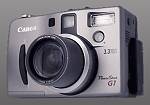 The good folks over at Steve's Digicams have now updated their first-look of Canon's PowerShot G1 digital camera to "full review" status, adding a lengthy conclusion to it. Here's a small sampling of Steve's thoughts: The good folks over at Steve's Digicams have now updated their first-look of Canon's PowerShot G1 digital camera to "full review" status, adding a lengthy conclusion to it. Here's a small sampling of Steve's thoughts:"The Canon PowerShot G1 is a very good contender in the current crop of semi-pro three megapixel cameras. Those who wanted the image size, camera features and speed of the Nikon 990 but with CompactFlash II (Microdrive) support, a more conventional designed body and a flash hot shoe will love the G1. Battery life is excellent even when using the color LCD. The G1 performs admirably as an easy to use "Automatic" camera and has more than enough real camera features to thrill even the most jaded digicam user. It's not going to fit in your pocket but you can hang it around your neck and carry it with you all day without fatigue. If you're looking for the ultimate "tourist" camera then think Canon G1 + 1GB Microdrive." For the full review from Steve's Digicams, click here!
Source: Steve's Digicams' Canon PowerShot G1 review

Saturday, October 14, 2000
Steve's Digicams reviews the DSC-F505V!
By Michael Tomkins, The Imaging Resource
(Saturday, October 14, 2000 - 23:02 EDT)
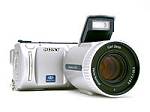 Our friends over at Steve's Digicams have posted their review of Sony's Cyber-shot DSC-F505V digital camera, a unit which (despite using a 3-megapixel imager) has an effective resolution of 2.6 megapixels, thanks to its using the same body as its predecessor, the DSC-F505. It also adds a number of other tweaks to the 'F505 design, and sports the same excellent 5x optical zoom lens. Here's what Steve had to say on the camera: Our friends over at Steve's Digicams have posted their review of Sony's Cyber-shot DSC-F505V digital camera, a unit which (despite using a 3-megapixel imager) has an effective resolution of 2.6 megapixels, thanks to its using the same body as its predecessor, the DSC-F505. It also adds a number of other tweaks to the 'F505 design, and sports the same excellent 5x optical zoom lens. Here's what Steve had to say on the camera:"If you're looking for an inconspicuous camera the F505V isn't for you. I often had people staring at me when they saw me holding it out like a raygun from the Star Wars movies. The "fit and finish" of the F505V is excellent, the body and lens is metal construction and seems very durable. The F505 takes great pictures but even with its hybrid LCD viewfinder it is not that easy to use this camera outdoors. If the sun is shining directly on the LCD it works great but in most cases you are usually somewhere between bright sunlight and shade. The high res JPEGs from the F505V are marvelous, well saturated and properly white balanced with very little (almost no) chromatic abberations and they are sharp as a tack thanks to that Zeiss lens.
If you can live with the limitations of an LCD-only camera then you'll probably be quite satisfied with the F505V. If not then I suggest that you look at one of the other cameras that offers both an LCD and an optical viewfinder." Be sure to check out Steve's full review here, and then for a second and third opinion, check out the review from DPReview, and of course our own DSC-F505 review!
Source: Steve's Digicams DSC-F505V review

Thursday, October 12, 2000
Full Review of Fujifilm FinePix 4900 Posted!
By David Etchells, The Imaging Resource
(Thursday, October 12, 2000 - 23:34 EDT)
 A busy week indeed at the Imaging Resource, and it's not over yet! (And this must be "Fuji 4900 Day, judging by the juxtaposition of this item and the one below about Steve's update of his own review.) Today we've just posted our full review of the Fujifilm FinePix 4900 Zoom, a unique SuperCCD-based digicam with a 6x true optical zoom lens and a host of advanced features. Our test unit was only a preproduction prototype, so the images need to be taken with a grain of salt: Wait for shots from the full production model before drawing any hard conclusions. Still, even in its preproduction state, the F4900 Zoom was a very impressive camera, with many, many nice user-interface features and tweaks, and good image quality all around. Fast, lots of features, a neat lens = A lot to like! Read the review for all the details! A busy week indeed at the Imaging Resource, and it's not over yet! (And this must be "Fuji 4900 Day, judging by the juxtaposition of this item and the one below about Steve's update of his own review.) Today we've just posted our full review of the Fujifilm FinePix 4900 Zoom, a unique SuperCCD-based digicam with a 6x true optical zoom lens and a host of advanced features. Our test unit was only a preproduction prototype, so the images need to be taken with a grain of salt: Wait for shots from the full production model before drawing any hard conclusions. Still, even in its preproduction state, the F4900 Zoom was a very impressive camera, with many, many nice user-interface features and tweaks, and good image quality all around. Fast, lots of features, a neat lens = A lot to like! Read the review for all the details!
Source: Imaging Resource review of Fujifilm FinePix 4900 Zoom

OmniVision announces single-chip CMOS-USB bridge!
By Michael Tomkins, The Imaging Resource
(Thursday, October 12, 2000 - 17:54 EDT)
 OmniVision Technologies Inc. has announced a new addition to its color digital camera support family. The OV518+, an enhanced single-chip camera-to-universal serial bus bridge, is designed for high-resolution USB PC applications. The OV518+ works with OmniVision's OV6620 (CIF) and OV7620 (VGA) color digital sensor chips. It is designed to support digital sensors up to 800x600 pixels. OmniVision combines a sensor and a USB chip, which creates a low-cost, highly integrated USB camera system without the need for external dynamic random access memory. OmniVision Technologies Inc. has announced a new addition to its color digital camera support family. The OV518+, an enhanced single-chip camera-to-universal serial bus bridge, is designed for high-resolution USB PC applications. The OV518+ works with OmniVision's OV6620 (CIF) and OV7620 (VGA) color digital sensor chips. It is designed to support digital sensors up to 800x600 pixels. OmniVision combines a sensor and a USB chip, which creates a low-cost, highly integrated USB camera system without the need for external dynamic random access memory.
The OV518+, along with an OmniVision sensor chip, is a low-cost, dual-chip solution for a high-resolution USB PC camera application. The OV518+ low-voltage (3.3V I/O and 2.5V core) design enables low power consumption and requires no external DRAM, keeping costs low. USB features include a built-in USB transceiver, eight isochronous interface alternates of up to seven megabits per second (Mbps) USB transfer rate and USB 1.1 compliance. Its audio interface includes a sampling rate of eight KHz and audio device class 1.0 compliance. The product features a proprietary real-time compression engine, a programmable switching power clock, serial camera control bus, general-purpose I/O pins and a built-in phase-locked loop (PLL)
Windows 98/2000 & ME drivers are available from OmniVision in addition to Apple Imac drivers. Reference designs and PC board layout are available. The OV518+ is sold with OmniVision's OV6620 and OV7620 products. The OV518+ in a 100-pin Quad Flat Pack (QFP) is immediately available for $7.00 in volume quantities.
Source: Yahoo! Finance / PR Newswire

Steve updates FinePix 4900 review!
By Michael Tomkins, The Imaging Resource
(Thursday, October 12, 2000 - 17:11 EDT)
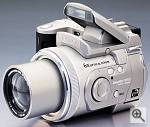 The folks at Steve's Digicams have just updated their review of Fuji's FinePix 4900 digital camera, first posted back at the end of September, from a first-look to a full review with conclusion... Steve has written a particularly long summary for the '4900, with lots of insight on how the camera meets its goals - here's a very brief snip: The folks at Steve's Digicams have just updated their review of Fuji's FinePix 4900 digital camera, first posted back at the end of September, from a first-look to a full review with conclusion... Steve has written a particularly long summary for the '4900, with lots of insight on how the camera meets its goals - here's a very brief snip:"I see the FinePix 4900 Zoom as a very worthy competitor to other cameras in its price and resolution class, it's loaded with features and performance and takes great pictures. The Electronic Viewfinder is a double-edged sword. It does give you TTL viewing and plenty of "heads up" data in the viewfinder but it's not the same quality that you get with a true SLR. The overall operation of the 4900 Zoom is very robust. Shooting in the 2400x1800 mode the camera processes and stores the images so fast I often wondered if it had actually captured the image or not." Incidentally, Steve is currently offering readers a chance to ask questions of Fujifilm's Darin Pepple in his forums, and so are we in our own forums. Even if don't have any questions yourself, we highly recommend checking out questions from others, and Darin's answers... Between Steve's forum and our own there's quite a lot of useful information for users of Fuji's digital cameras, or anybody considering purchasing one. You don't need to sign up to read or post messages in our forums, so hop on over and ask Fuji your questions now!

Wednesday, October 11, 2000
iPIX opens Japanese office!
By Michael Tomkins, The Imaging Resource
(Wednesday, October 11, 2000 - 18:10 EDT)
 Oak Ridge, TN-based Internet Pictures Corp. has announced the opening of Internet Pictures Japan Kabushiki Kaisha (iPIX Japan), marking iPIX's entry into the Japanese market. As part of the announcement, SOFTBANK E-COMMERCE CORP. has invested in iPIX Japan, thus receiving a minority stake in the company. iPIX Japan will work with SOFTBANK E-COMMERCE's group companies to provide imaging solutions to Web sites and wireless devices. Oak Ridge, TN-based Internet Pictures Corp. has announced the opening of Internet Pictures Japan Kabushiki Kaisha (iPIX Japan), marking iPIX's entry into the Japanese market. As part of the announcement, SOFTBANK E-COMMERCE CORP. has invested in iPIX Japan, thus receiving a minority stake in the company. iPIX Japan will work with SOFTBANK E-COMMERCE's group companies to provide imaging solutions to Web sites and wireless devices. "With over 21 million Internet users in Japan (according to Nielson Ratings, March 2000), the need for rich media and dynamic imaging on Web sites is inherent," said Andy Okada, SOFTBANK E-COMMERCE CORP.'s senior vice president, business planning. "By adding iPIX -- the leader of dynamic imaging -- to our high-profile portfolio that includes leading companies such as CarPoint, VerticalNet, and SmartFirm, SOFTBANK E-COMMERCE CORP's investment will serve as a catalyst for bringing imaging solutions to Web sites and wireless devices throughout Japan." "With over 21 million Internet users in Japan (according to Nielson Ratings, March 2000), the need for rich media and dynamic imaging on Web sites is inherent," said Andy Okada, SOFTBANK E-COMMERCE CORP.'s senior vice president, business planning. "By adding iPIX -- the leader of dynamic imaging -- to our high-profile portfolio that includes leading companies such as CarPoint, VerticalNet, and SmartFirm, SOFTBANK E-COMMERCE CORP's investment will serve as a catalyst for bringing imaging solutions to Web sites and wireless devices throughout Japan."
iPIX Japan plans to form strategic alliances with leading Japanese partners to bring full and self-service dynamic imaging solutions to the wireless, real estate, travel and hospitality, and entertainment markets. iPIX Japan will use the company's PIXcast Network, a global infrastructure that delivers a range of immersive imaging solutions to customers worldwide, including still pictures, motion pictures, immersive pictures and more.
iPIX Japan will offer customers the following:- Capture and Processing of Immersive, 360-Degree Images
- Image Management and Hosting
- Distribution to the Web
"Japan represents an enormous opportunity with respect to wireless applications, digital imaging and the Internet," said Don Strickland, president of iPIX. "We're thrilled to receive not only backing from one of the world's most recognized names in Internet investing and properties, but endorsement of the critical importance of dynamic imaging to Internet businesses worldwide. A relationship with SOFTBANK E-COMMERCE CORP. will provide the foundation for a powerful presence in this exciting Japanese marketplace."
Source: Yahoo! Finance / PR Newswire

Tuesday, October 10, 2000
Sony shows numerous digicam concepts at CEATEC!
By Michael Tomkins, The Imaging Resource
(Tuesday, October 10, 2000 - 17:24 EDT)

Consumer electronics giant Sony Corp. took the opportunity to showcase its MemoryStick flash media format at the CEATEC (Combined Exhibition of Advanced Technologies) show, held October 3rd - 7th in Japan, and Juergen Specht (the man behind the busy D1scussion mailing list for photographers using or interested in Nikon's D1 digital camera) was there. Juergen has posted a superb gallery with 113 photos from CEATEC on his website, and has kindly allowed us to redistribute several pictures which show Sony's interesting concepts...
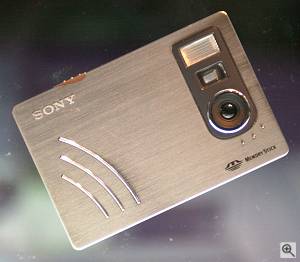
 First up was a camera on a neckstrap, seen at the top of this news item.The unnamed camera, despite its small size, still manages to fit in an optical viewfinder alongside the lens... Next up was a credit-card sized camera shown in the photo directly above, and again from an angle in the photo on the right. Again, the camera has an optical viewfinder, and despite being so incredibly slim, it also has a flash... Unfortunately we can't see the back and hence have no idea if the designs for either camera provide for an LCD display of any kind, but particularly with the credit card-shaped camera, we could definitely see a design that was so portable (stick it in your wallet and it is there wherever you go) being extremely useful, even without the LCD or a zoom lens... First up was a camera on a neckstrap, seen at the top of this news item.The unnamed camera, despite its small size, still manages to fit in an optical viewfinder alongside the lens... Next up was a credit-card sized camera shown in the photo directly above, and again from an angle in the photo on the right. Again, the camera has an optical viewfinder, and despite being so incredibly slim, it also has a flash... Unfortunately we can't see the back and hence have no idea if the designs for either camera provide for an LCD display of any kind, but particularly with the credit card-shaped camera, we could definitely see a design that was so portable (stick it in your wallet and it is there wherever you go) being extremely useful, even without the LCD or a zoom lens...
A third photo (below) shows Sony's unnamed prototype which uses "Memory Stick Duo", and which we first told you about back on July 27th. Unlike the other cameras in this news item, which could be prototypes that work to some degree, or just mockups to demonstrate a concept, this one actually works! It features a 330,000 pixel image sensor (VGA 640 x 480 pixel image size), 0.55 inch 180,000 pixel LCD display, Lithium Ion battery and MemoryStick Duo storage up to 64MB, in a tiny 22 x 63 x 13mm package that weighs only 26 grams including battery! Amazing stuff...

Finally, three more photos show a range of potential applications for MemoryStick. The first photo shows, clockwise from the top of the picture above the word "Stick":- Sony GPS (Global Positioning System) stick
- Sony Digital Zoom Mic stick
- Sony Picture Index stick
- Sony Memory Check stick
- Sony Multi Use Jog stick
- Sony Infostick
- Sony Finger-ID stick
- Sony Active Speaker stick
- Sony TV Tuner stick
- Sony FM Data Receiver stick
- Sony Digital Still Camera stick
- Sony Digital Camera Stick
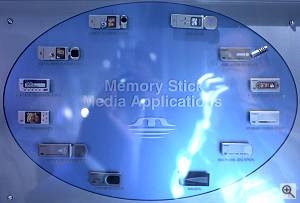
The second photo (below) shows the Sony Digital Camera stick in close-up, alongside the GPS stick, whilst the final photo (bottom) shows the Sony Digital Still Camera stick (does the distinction between "digital still camera" and "digital camera" mean the first cam might have video capabilities? We don't know, but it could be that Sony is trying to suggest this...)


Thanks very much indeed to Juergen Specht for allowing us to use his great images!
Source: Juergen Specht's CEATEC image gallery

DPReview posts Canon EOS D30 production review!
By Michael Tomkins, The Imaging Resource
(Tuesday, October 10, 2000 - 12:43 EDT)
 Our good friends over at the Digital Photography Review website have just updated their review of Canon's EOS D30 SLR digital camera. The review now covers a production model D30, with firmware version 1.00. There's plenty of sample pictures, and the usual in-depth review of camera features and control, spread out over a whopping 20 pages and two sample galleries... Phil's conclusion? Here's a small sampling: Our good friends over at the Digital Photography Review website have just updated their review of Canon's EOS D30 SLR digital camera. The review now covers a production model D30, with firmware version 1.00. There's plenty of sample pictures, and the usual in-depth review of camera features and control, spread out over a whopping 20 pages and two sample galleries... Phil's conclusion? Here's a small sampling:"The D30 is a very complete, very satisfying camera to use, and time after time you'll load up images and (straight out of the camera) be amazed... Isn't this what photography is all about? As you can see, I like the EOS-D30. A lot.
Sure, there are things I'd like to see improved, the odd little niggle here and there, nothing that would change the photography experience itself. Value for money? Unbeatable (at the time of writing this review). I have no doubt that Canon will sell every single D30 they ever produce, the question is can they make enough of them?" For the full story, head on over to the Digital Photography Review's Canon EOS D30 production review...
Source: Digital Photography Review Canon EOS D30 review

Steve's Digicams reviews Maha, HubGiant chargers!
By Michael Tomkins, The Imaging Resource
(Tuesday, October 10, 2000 - 11:46 EDT)

Our friends over at the Steve's Digicams website have just posted two new accessory reviews. First up is a review of Maha's MH-C2000 Lithium Ion (LiIon) / Nickel Metal Hydride (NiMH) / Nickel Cadmium (NiCad) battery charger, an interesting unit that can charge everything from a huge range of batteries including, amongst others, Sony's InfoLithium series and standard AA and AAA rechargeables. Here's what Steve concludes:"The C2000 is a well constructed and lightweight battery charger that can be used on either 110VAC or from any 12VDC power source in a car, boat, etc. It is much faster than any of the regular chargers supplied with camcorders or still cameras and can be your "one does it all" charger for a camcorder as well as a still camera that uses AA type batteries. For the money this is a lot of charger and nobody knows batteries or chargers better than the Maha folks, they've been at it for a long time." 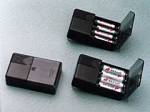 Steve also reviews Taiwanese electronics company HubGiant's CHG2000 "Lightning Pack 2000" charger and Sanyo's 1600mAh NiMH batteries, concluding: Steve also reviews Taiwanese electronics company HubGiant's CHG2000 "Lightning Pack 2000" charger and Sanyo's 1600mAh NiMH batteries, concluding:"The Lightning Pack 2000 is a very compact and fast charger that can be easily stowed in your camera bag by folding back the AC prongs. In fact, it makes a great holder for your second set of batteries when not in use as a charger. The Sanyo 1600mAh NiMH batteries are definitely 'heavy duty' cells that equal (or better) the Kodak 1600mAh NiMH at a lower cost."

UPDATED: HP announces C215, C315 digital cameras!
By Michael Tomkins, The Imaging Resource
(Tuesday, October 10, 2000 - 2:06 EDT)
 Hewlett-Packard Co. has announced two point-and-shoot digital cameras that are aimed at first-time buyers, the 2.1 megapixel HP PhotoSmart 315 digital camera, and the 1.3 megapixel HP PhotoSmart 215 digital camera. Hewlett-Packard Co. has announced two point-and-shoot digital cameras that are aimed at first-time buyers, the 2.1 megapixel HP PhotoSmart 315 digital camera, and the 1.3 megapixel HP PhotoSmart 215 digital camera.
The HP PhotoSmart 315 digital camera, priced at $299, is a fully automatic point-and-shoot digital camera that features 2.1-megapixel resolution. The camera also has a 2.5x digital interpolation feature, 1.8-inch high-resolution color LCD and wireless printing via HP JetSend infrared technology. The camera ships with an 8MB CompactFlash card and HP photo imaging software, and is compatible with both PC and USB-connect Macintosh systems. The HP PhotoSmart 315 is now shipping to retailers worldwide.
The HP PhotoSmart 215 digital camera, priced at $199, features 1.3-megapixel resolution, 2x digital interpolation and a 1.8-inch color LCD, as well as auto flash, auto focus and exposure, and a self timer. The camera ships with a 4MB CompactFlash memory card and a USB cable for fast downloading of images. ArcSoft Photo Impression and ArcSoft Photo Montage software are bundled. The HP PhotoSmart 215 digital camera is expected to ship in mid-October.
HP has also started shipping the HP PhotoSmart 912 and 618 digital cameras; the HP PhotoSmart 912 digital camera is priced at $799, whilst the HP PhotoSmart 618 digital camera is priced at $599.
Here's the full specs for the new cameras:
 - HP PhotoSmart C215 digital camera
- 1.3 megapixel 1/2.7" CCD image sensor. Produces JPEG images at resolutions of 1280 x 960 or 640 x 480 pixels.
- 6.68mm F2.8 all-glass fixed focal length lens equivalent to 43mm on a 35mm camera, with 5 elements. 2x digital interpolation.
- Optical viewfinder and 1.8" 61,600 pixel LCD display
- CompactFlash Type-I storage, 4MB card bundled
- Built-in flash
- ISO 100 rating
- Shutter speeds 1/760 to 1/3 second, automatically selected
- Apertures of f/2.8 or f/8, automatically selected
- TTL autofocusing, range of 60cm to infinity in normal mode, 10cm to infinity in macro mode
- Auto white balance
- 10 second self-timer
- USB connectivity compatible with both PC and Macintosh
- Available in mid-October at a price of US$199
 - HP PhotoSmart C315 digital camera
- 2.11 megapixel 1/2.7" CCD image sensor. Produces JPEG images at resolutions of 1600 x 1200 or 640 x 480 pixels.
- 5.8mm F2.8 all-glass fixed focal length lens equivalent to 38mm on a 35mm camera, with 5 elements. 2.5x digital interpolation.
- Optical viewfinder and 1.8" 72,000 pixel LCD display
- CompactFlash Type-I storage, 8MB card bundled
- Built-in flash
- ISO 100 rating
- Shutter speeds 1/750 to 2 seconds, automatically selected
- Apertures of f/2.8, 3.9, 5.6 or 9.8, automatically selected
- TTL autofocusing, range of 30cm to infinity
- Auto white balance
- +/- 2.0EV exposure compensation in 0.5EV steps
- 10 second self-timer
- IrDA infrared connectivity compatible with JetSend printers
- USB connectivity compatible with both PC and Macintosh
- Available immediately at a price of US$299
Thanks to IR readers Steve Webster and Allyn Fratkin for noticing that we'd unintentionally gotten some specs for the two cameras reversed. We've corrected this now (08:53AM EST), and promise to lay off the coffee when proofreading from now on! ;)
Source: Yahoo! Finance / Business Wire

Monday, October 9, 2000
Full review of Kodak DC3400 Posted!
By David Etchells, The Imaging Resource
(Monday, October 9, 2000 - 16:29 EDT)
 Our second review of the day is for the Kodak DC3400. This is basically an update of Kodak's earlier and very popular DC280 two megapixel point & shoot digicam. (BTW, there are some great deals floating around on the DC280 at the moment, now that it's being phased out in favor of the new 3400!) The new DC3400 is also a two megapixel design, but apparently uses a slightly smaller CCD chip and has other changes to its electronics that result in slightly lower power consumption. Other than that, performance seems very similar to the DC280, which suggests the DC3400 will enjoy the same success in the market. (This seems like a good "middle of the road" two megapixel unit - good picture quality, a good assortment of controls and a 2x zoom lens, yet still a very easy user interface.) Read the review for all the details! Our second review of the day is for the Kodak DC3400. This is basically an update of Kodak's earlier and very popular DC280 two megapixel point & shoot digicam. (BTW, there are some great deals floating around on the DC280 at the moment, now that it's being phased out in favor of the new 3400!) The new DC3400 is also a two megapixel design, but apparently uses a slightly smaller CCD chip and has other changes to its electronics that result in slightly lower power consumption. Other than that, performance seems very similar to the DC280, which suggests the DC3400 will enjoy the same success in the market. (This seems like a good "middle of the road" two megapixel unit - good picture quality, a good assortment of controls and a 2x zoom lens, yet still a very easy user interface.) Read the review for all the details!
Source: IR review of Kodak DC3400

Full review of Kodak DC3800 posted!
By David Etchells, The Imaging Resource
(Monday, October 9, 2000 - 15:16 EDT)
 Well, David Kamanski of Digital Eye (see the news item below) beat us by a day or so with his own review of the Kodak DC3800, but we weren't far behind. The DC3800 is an ultra-simple, ultra-compact 2 megapixel digicam, intended as a drop-in-the-pocket, take-it-anywhere design. While its feature set is very basic, we found that it took surprisingly good pictures in a range of circumstances. About the only thing we really felt was missing (eg, that should have been included but wasn't) was an exposure-compensation adjustment. While many prospective users of the DC3800 could probably care less about exposure compensation, we feel it's a near-necessity on a digicam. Lacking this, the DC3800 ended up underexposing our "outdoor portrait" test fairly severely. That said though, we were surprised by how good a job the automatic white balance did with our very tough, incandescent-lit "indoor portrait" shot. Overall, a great pocket- or purse-cam, if you want absolute point & shoot simplicity, but enough resolution to make good 8x10 prints. Read the review for all the details! Well, David Kamanski of Digital Eye (see the news item below) beat us by a day or so with his own review of the Kodak DC3800, but we weren't far behind. The DC3800 is an ultra-simple, ultra-compact 2 megapixel digicam, intended as a drop-in-the-pocket, take-it-anywhere design. While its feature set is very basic, we found that it took surprisingly good pictures in a range of circumstances. About the only thing we really felt was missing (eg, that should have been included but wasn't) was an exposure-compensation adjustment. While many prospective users of the DC3800 could probably care less about exposure compensation, we feel it's a near-necessity on a digicam. Lacking this, the DC3800 ended up underexposing our "outdoor portrait" test fairly severely. That said though, we were surprised by how good a job the automatic white balance did with our very tough, incandescent-lit "indoor portrait" shot. Overall, a great pocket- or purse-cam, if you want absolute point & shoot simplicity, but enough resolution to make good 8x10 prints. Read the review for all the details!
Source: IR Review of Kodak DC3800

DCRP reviews Fuji FinePix 40i, 1300!
By Michael Tomkins, The Imaging Resource
(Monday, October 9, 2000 - 15:00 EDT)
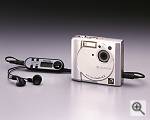 The folks at the Digital Camera Resoure Page have been hard at work on some new reviews, the first results of which have now been posted. First up, Jeff reviews the Fuji Finepix 40i, a 2.4 megapixel SuperCCD camera with MP3 player capabilities. Here's how Jeff summarises the '40i: The folks at the Digital Camera Resoure Page have been hard at work on some new reviews, the first results of which have now been posted. First up, Jeff reviews the Fuji Finepix 40i, a 2.4 megapixel SuperCCD camera with MP3 player capabilities. Here's how Jeff summarises the '40i:"The Fuji Finepix 40i is an interesting concept camera for sure. I suppose sales will decide if another camera like this comes out. As a camera, it does a pretty good job, though I'd love to see an optical zoom on it. As an MP3 player, it's fine, but it's almost useless without a couple of large memory cards. It seems like Fuji cut a few corners to merge these two devices. What I'd like to see in the next version of this camera (if there is one) is a FinePix 4700 with the MP3 functionality, with a 128MB SmartMedia card! I can dream, right?" 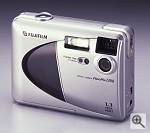 Next up is Jeff's review of a pre-production Fuji FinePix 1300 (usual caveat here - pre-production cameras usually show significant differences to final-version cameras, particularly in image quality, so take note)... Jeff concludes: Next up is Jeff's review of a pre-production Fuji FinePix 1300 (usual caveat here - pre-production cameras usually show significant differences to final-version cameras, particularly in image quality, so take note)... Jeff concludes:"The Fuji FinePix 1300 is a good, entry-level camera for those wanting to try out digital photography. You won't get all the bells and whistles that you'll find on higher end cameras, but for everyday point-and-shoot action, the 1300 will do just fine." Both reviews include the usual look at camera control and layout, images of the camera itself and sample photos. If you're considering either camera, be sure and read the full reviews!

Sunday, October 8, 2000
Digital Eye reviews the Kodak DC3800!
By Michael Tomkins, The Imaging Resource
(Sunday, October 8, 2000 - 17:33 EDT)

The good folks over at the Digital Eye website have posted the first review we've seen of Kodak's DC3800 digital camera. Here's how they summarise this 2.3 megapixel, fixed-focal length camera:"The picture results (both on screen and on glossy photo paper) of the DC3800 compare very favourably to other 2 Megapixel cameras and the $499 price range. With the added bonus of having a very small, lightweight and simple to use camera that is more likely to be taken with you when ever you might want to capture some pictures, we think the DC3800 is a great choice for at least one of your digital camera solutions. Overall, the DC3800 at $499 and with everything you need to easily get into digital photography, is a very practical choice which we certainly can highly recommend." Be sure to check out the full review with sample pictures and an in-depth look at the camera itself...
Source: Digital Eye's Kodak DC3800 review

64MB CompactFlash for $89 still to high? Try $75!
By Michael Tomkins, The Imaging Resource
(Sunday, October 8, 2000 - 16:40 EDT)
We posted back on Wednesday about a great deal on 64MB CompactFlash - $89 including shipping - but it seems that just when we think we really can't find a price much better we have to stand corrected. :) IR reader Michael A. Montes wrote in with an even more astounding price of $75 for a 64MB CompactFlash card, and this is one of Lexar's JumpShot cards which has built-in USB connectivity and hence doesn't need an extra card-reader! All-in, including shipping, you can get the 64MB JumpShot card for $80 if you order by October 13th - so hurry on over to the Deals page for the full story!

Megapixel October issue online!
By Michael Tomkins, The Imaging Resource
(Sunday, October 8, 2000 - 16:18 EDT)
Our good friends over at the megapixel.net website have now posted their October issue. New reviews this month include:- Olympus D-460 Zoom (1.3 megapixel, 3X Zoom)
- Kodak DC-4800 (3.34 megapixel, 3X Zoom)
- Nikon CoolPix 880 (3.34 megapixel, 2.5 Zoom)
- Sony Mavica MVC-CD1000 (2.1 megapixel, 10X Zoom)
There's also an article from Paul Sullivan summarising his past 'digital' year, a poll on the best cover photo from the last year, a Beginner's Guide: to digital cameras, and a collection of macro photos from readers... Great stuff as usual!

Friday, October 6, 2000
Miss the Olympics on TV? Order a photo!
By Michael Tomkins, The Imaging Resource
(Friday, October 6, 2000 - 17:38 EDT)
Professional online photo agency NewsDX is offering on its website a range of images from the Sydney 2000 Olympic games. Through an agreement with Sport the Library, a division of Australasian Sporting Pictures and a leading sports photography provider in Australia, NewsDX used Sport the Library’s team of photographers to provide worldwide distribution of photographic content from the games, enabling news agencies to review and purchase rights-of-use to images, and individuals to order images for personal use, from an wide selection of sports events, athletes and nationalities.

NewsDX's archive is easily searchable, and contains some pretty amazing photos, such as the image above of Olympic fencing, with French fencer Hughes Obry lifting opponent Marcel Fischer of Switzerland right off the mat in a move that is both stunning and beautiful to look at. (We've cropped the image down to better fit the format of the News page - click on it to get the full effect!)
With Christmas only a few months away, we're sure there will be many sporting enthusiasts out there who'd love nothing more than to receive a framed print of their own Olympic hero... NewsDX' site lists the cost of each photo ordered for personal use as a very reasonable $20.

New online digital photography magazine forms!
By Michael Tomkins, The Imaging Resource
(Friday, October 6, 2000 - 13:33 EDT)
We've had a couple of emails recently from IR reader Uwe Steinmuller regarding his new website, Digital Outback Photo. Uwe set the site up for digital photographers to share their passion for outdoor photography. Readers can submit photos of their own, and share photography tips; there's a tutorial on perspective correction, a tutorial on how to handle .NEF files from the Nikon D1 camera (along with a sample file), and much more... If you're interested in outdoor photography, be sure and check out Digital Outback Photo!

Thursday, October 5, 2000
PhotoHighway announces Halloween contest!
By Michael Tomkins, The Imaging Resource
(Thursday, October 5, 2000 - 19:23 EDT)
 PhotoHighway.com has launched a new Halloween contest for its members. The contest features a free trial version of 'The Home Gene-Splicing Kit', a software package from You-Betcha Interactive. PhotoHighway.com has launched a new Halloween contest for its members. The contest features a free trial version of 'The Home Gene-Splicing Kit', a software package from You-Betcha Interactive.
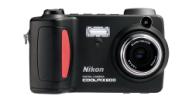 "PhotoHighway.com continues to showcase great digital imaging activities for its members." says Mark Schott, Vice President of Marketing at PhotoHighway.com. "We have a large membership base that is eager to increase their knowledge and enjoyment of digital photography. Halloween is a fun time of year for the whole family, and The Home Gene-Splicing Kit is so easy to use that adults and children of all ages can join in this fun contest." "PhotoHighway.com continues to showcase great digital imaging activities for its members." says Mark Schott, Vice President of Marketing at PhotoHighway.com. "We have a large membership base that is eager to increase their knowledge and enjoyment of digital photography. Halloween is a fun time of year for the whole family, and The Home Gene-Splicing Kit is so easy to use that adults and children of all ages can join in this fun contest."
"We are delighted to work with PhotoHighway.com to create this special Halloween contest," says Mary Jo Reutter of You-Betcha Interactive. "Our software is targeted at family users, and PhotoHighway.com has a large membership that matches our target users very well. We think the PhotoHighway contest is an ideal way to show off our great software product." A free trial version of The Home Gene-Splicing Kit software can be downloaded from You-Betcha's web site. Full details of the contest can be found at PhotoHighway's site. The Halloween contest runs through the end of October. A free trial version of The Home Gene-Splicing Kit software can be downloaded from You-Betcha's web site. Full details of the contest can be found at PhotoHighway's site. The Halloween contest runs through the end of October.
Source: Yahoo! Finance / Internet Wire

MegaChips, Displaytech partner on digicam display solution!
By Michael Tomkins, The Imaging Resource
(Thursday, October 5, 2000 - 0:11 EDT)
MegaChips Corp., a manufacturer of LSI image processing chips, has announced that it is working with Displaytech Inc. to design and manufacture image processing chips specifically enabled to work with Displaytech's QVGA microdisplays.
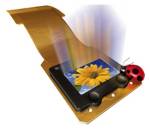 MegaChips' LSI imaging chip will be combined with Displaytech's microdisplay to offer digital camera OEMs an image capture and display solution that the companies claim has 'outstanding quality'. Able to process images up to 16 megapixel CCD, MegaChips' LSI 'far surpasses' the current top-end market offering of six megapixels, the press release continues. The chip offers a capture rate of six pictures/second at three megapixels and 60 pictures/second at VGA resolution, and is claimed to be 'the fastest chip commercially available'. MegaChips' LSI imaging chip will be combined with Displaytech's microdisplay to offer digital camera OEMs an image capture and display solution that the companies claim has 'outstanding quality'. Able to process images up to 16 megapixel CCD, MegaChips' LSI 'far surpasses' the current top-end market offering of six megapixels, the press release continues. The chip offers a capture rate of six pictures/second at three megapixels and 60 pictures/second at VGA resolution, and is claimed to be 'the fastest chip commercially available'. "The large amount of information our chips process directly translates into the highest-quality digital photos available today," said Akihiko Saito at MegaChips. "The high-resolution and outstanding image quality of Displaytech's microdisplays make them a natural choice to display these images. By manufacturing processing chips for Displaytech, we are offering our customers performance and image quality previously reserved for high-end film cameras." "The large amount of information our chips process directly translates into the highest-quality digital photos available today," said Akihiko Saito at MegaChips. "The high-resolution and outstanding image quality of Displaytech's microdisplays make them a natural choice to display these images. By manufacturing processing chips for Displaytech, we are offering our customers performance and image quality previously reserved for high-end film cameras."
MegaChips will begin manufacturing chips for Displaytech's microdisplays in the fourth quarter of this year. The combined displays and chip sets will be available to camera OEMs in the first quarter of 2001. "We need to offer our digital camera OEMs a display package that combines superior image quality with high-performance processing capabilities," said J.P. Valiulis, senior director of business development for Displaytech. "Working with MegaChips means we can offer our customers display performance suitable for professional studios, but at a price point in the range of the pocket camera market. This will allow manufacturers to design new concepts for the next generation of consumer digital cameras." "We need to offer our digital camera OEMs a display package that combines superior image quality with high-performance processing capabilities," said J.P. Valiulis, senior director of business development for Displaytech. "Working with MegaChips means we can offer our customers display performance suitable for professional studios, but at a price point in the range of the pocket camera market. This will allow manufacturers to design new concepts for the next generation of consumer digital cameras."
Smaller than a postage stamp, microdisplays offer an alternative to conventional display options. Their size and light weight translate into smaller, thinner and lighter camera designs. Microdisplays also use significantly less power than other display options, with the press release claiming that 'battery life is measured in months, rather than hours'.
Source: Yahoo! Finance / PR Newswire

Wednesday, October 4, 2000
DCRP reviews Nikon's Coolpix 880!
By Michael Tomkins, The Imaging Resource
(Wednesday, October 4, 2000 - 23:43 EDT)
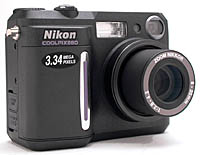 Our good friends over at the Digital Camera Resource Page have posted their review of Nikon's recently-announced Coolpix 880 digital camera. Here's what Jeff had to say about the '880: Our good friends over at the Digital Camera Resource Page have posted their review of Nikon's recently-announced Coolpix 880 digital camera. Here's what Jeff had to say about the '880:"[The] Coolpix 880 isn't much of a "baby brother" at all to the Coolpix 990 -- it's almost a twin. The major differences are: the lens, slower processing and less buffer memory, and no support for external flashes. The CP880 does have some tricks that the 990 doesn't, like scene and CSM modes. All in all, if you're looking for a camera with all the manual controls you desire, but don't want to break the bank, then the Coolpix 880 is for you! " Head on over to the DCRP for the full review, complete with sample images and pictures of the camera itself.
Source: Digital Camera Resource Page Nikon Coolpix 880 review

64MB CompactFlash for $89 including shipping? Wow!
By Michael Tomkins, The Imaging Resource
(Wednesday, October 4, 2000 - 20:35 EDT)
We don't normally cross-post items from the Deals page on the News page, but for the second time this week we find ourselves doing so... Thanks to IR reader Brian Pope, we have a real jaw-dropper of a deal for readers, which we think you'll agree is worthy of noting. Brian pointed us towards a source for Kingston's 64MB CompactFlash cards for only $89 - including shipping! For the whole story, hop on over to the Deals page... And our thanks to Brian for the email!

PhotoChannel relaunches site!
By Michael Tomkins, The Imaging Resource
(Wednesday, October 4, 2000 - 15:16 EDT)
PhotoChannel Networks Inc. has announced the launch of Version 2.0 of its Internet photography site, offering online photo print services for digital and conventional film photographers. The site now offers a way to store and share images and order prints, reprints and enlargements. The site features a range of photography news, tips and digital camera reviews; an online photo print service to digitize, store, share and print pictures; and an online store where camera equipment, accessories and supplies are available.
 PhotoChannel offers a wide range of services to digital as well as film photographers. Digital photographers can upload images directly to their own photo site, whilst 35mm and APS photographers can send their film or disposable camera for free processing, scanning and uploading by using postage paid mailers which can be requested from PhotoChannel. Free "custom darkroom" programming is available for easy editing and enhancement of images including image cropping, special effects, red-eye removal as well as "digital" framing. PhotoChannel offers a wide range of services to digital as well as film photographers. Digital photographers can upload images directly to their own photo site, whilst 35mm and APS photographers can send their film or disposable camera for free processing, scanning and uploading by using postage paid mailers which can be requested from PhotoChannel. Free "custom darkroom" programming is available for easy editing and enhancement of images including image cropping, special effects, red-eye removal as well as "digital" framing.
After selecting the images they want to print, customers have their pictures shipped within 24 hours of PhotoChannel receiving their order. PhotoChannel provides these photography services to all photography enthusiasts whether they use digital cameras, conventional 35mm and APS cameras, or single use (disposable) cameras. PhotoChannel notes that it 'is the only online photo community which makes prints using the highest quality state-of-the-art Fuji Frontier Digital Minilabs and premium Fuji Crystal Archive Silver-Halide Paper for unsurpassed quality and low-cost prints'. The prints are developed and sent to users within 24 hours, at a cost of $7.99 for up to 24 prints.
The new PhotoChannel also brings customers photography news, reviews, tips, and techniques from photographers and well-known imaging industry leaders. The expanded editorial includes a new Photography Pro's column from respected photography columnist Don Sutherland, who travels extensively to provide insight on the latest developments in the photographic world. Dave Etchells, the publisher of Imaging Resource Inc. contributes extensive digital camera and software comparative reviews for consumers confused with the deluge of choices in cameras, printers and storage."We expect users to be extremely impressed with the extraordinary quality of PhotoChannel's prints. They're sharper, clearer, more vibrant, and delivered more quickly than other online photo print service," said Geoffrey G. Briant, Chairman and CEO of PhotoChannel Networks Inc. "Experts have estimated that by 2002, there will be more than 5.5 billion images uploaded to the Internet and still exposures will grow from 71 billion in 1997 to over 100 billion. PhotoChannel helps bring all photographers into the digital era through expanding and enhancing customers' enjoyment of photography by creating a synergy between film, digital imaging and the Internet." PhotoChannel's press release highlights the following new features on the site:- Free one-button batch uploads of digital photos
- Free, postage paid mailers available for 35mm, APS and single use disposable cameras.
- Free processing, scanning and uploading of all pictures on film.
- Free posting to a free, personalized PhotoChannel PhotoSite account.
- Free storage, albums and slide shows.
- Free, unlimited viewing, editing and photo sharing.
- Free "custom darkroom" for easy editing and enhancement of images including image cropping, special effects, red-eye removal as well as "digital" framing.
- Free online slide shows and photo albums for friends and family to view.
- Choice of images to print.
- Online store with a range of digital photography products.
- Photo prints and enlargements of the highest quality at competitive prices.
- Expanded editorial with new columns from photographers and industry experts.
Source: Yahoo! Finance / Canada NewsWire

FlashPoint Digita receives US patent!
By Michael Tomkins, The Imaging Resource
(Wednesday, October 4, 2000 - 12:58 EDT)
 FlashPoint Technology, Inc., the company behind the Digita operating system used in some digital cameras, has announced that the United States Patent and Trademark Office has issued a patent for the graphical user interface of FlashPoint's Digita OE. FlashPoint Technology, Inc., the company behind the Digita operating system used in some digital cameras, has announced that the United States Patent and Trademark Office has issued a patent for the graphical user interface of FlashPoint's Digita OE."Traditionally, users of digital cameras had to memorize many different key sequences to operate different modes of the camera," said Eric Anderson, FlashPoint's chief technical officer and a named inventor on the patent. "The Digita user interface allows operating modes to be mapped against a global navigational device, making navigation through the camera's operational modes more intuitive."
"Usability is a critical factor in the success of any handheld technology," said FlashPoint president Stephen Saylor, also a named inventor. "FlashPoint's leadership in user-friendly design is well recognized by our licensees and the third-party developer community. This patent further demonstrates the innovation in the Digita OE method and contributes to FlashPoint's leading intellectual property position." The 20-page patent, U.S. number 6,118,480, entitled "Method And Apparatus for Integrating a Digital Camera User Interface across Multiple Operating Modes," was issued on September 12, 2000.
 The patented GUI design allows users to navigate, using buttons, through the camera's operating modes as menu options are displayed on the camera's LCD screen, providing an intuitive interaction with the camera. The patented GUI design allows users to navigate, using buttons, through the camera's operating modes as menu options are displayed on the camera's LCD screen, providing an intuitive interaction with the camera.
Source: Yahoo! Finance / Business Wire

CF Capacity Race Continues: 256MB from Viking
By David Etchells, The Imaging Resource
(Wednesday, October 4, 2000 - 12:14 EDT)
It's hard to keep track of the ever-increasing CF memory capacities, but I think this is a new record for Type I CF cards: Viking Components has just announced the imminent (well, "fourth quarter", anyway) shipment of 256MB CF Type I cards. That's a LOT of storage, particularly in a type I slot. (I think the biggest we'd seen previously was 244MB from Delkin.) No mention of cost, but they're sure not to be cheap. Overall, the IBM Microdrive still wins the capacity race hands-down, but it's in the fatter TypeII form factor, so won't fit many cameras. The flash-memory based cards also have the advantage of no moving parts, which should make them more rugged. So, for all of you with TypeI-only digicams, here's some serious capacity for you!
Source: Viking press release

Epson chops 870, 875DC printer prices!
By David Etchells, The Imaging Resource
(Wednesday, October 4, 2000 - 12:06 EDT)
 Epson America Inc. has announced that it has lowered the price of the EPSON Stylus Photo 870 and EPSON Stylus Photo 875DC printers. Previously priced at $299 and $399 respectively, the printers have been reduced to $249 and $299. This represents a drop of 17% for the '870, and 25% for the '875DC. Both printers offer photo quality output and high speeds, according to Epson's release. Epson America Inc. has announced that it has lowered the price of the EPSON Stylus Photo 870 and EPSON Stylus Photo 875DC printers. Previously priced at $299 and $399 respectively, the printers have been reduced to $249 and $299. This represents a drop of 17% for the '870, and 25% for the '875DC. Both printers offer photo quality output and high speeds, according to Epson's release.
The Stylus Photo 870 and 875DC feature 1440 x 720 dpi true hardware resolution and Epson's 'Advanced Micro Piezo' ink jet technology, a six-color photo ink system offering good detail and skin tones, sharper contrast and a wide color range. The printers also offer four-picoliter, variable-sized droplets, delivering up to 69 levels of tone, which Epson claims is more than twice that of any other ink jet printer. Both printers can also make continuous edge-to-edge 4" x 6" marginless snapshot prints that the company believes 'look and feel like pictures from a traditional photo lab'."The outstanding photo quality of the EPSON Stylus Photo 870 and 875DC has truly set a new standard for ink jet photo printing," said Fabia Ochoa, product manager, photographic reproduction printers, Epson. "With these products, home users and digital imaging hobbyists can get the best photo quality at a great value." 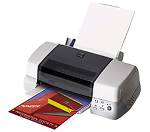 The EPSON Stylus Photo 870 features a maximum printable area of 8.26" x 43.76", the printer can handle a variety of paper sizes, including letter, legal and panoramic sizes up to 8.5" x 44". It is both Windows and Macintosh compatible, featuring USB, parallel and optional network connectivity. Included with the printer is the EPSON Digital PhotoLab Starter Kit containing a roll paper holder, EPSON Film Factory photo management software and Adobe Photo Deluxe. The EPSON Stylus Photo 870 features a maximum printable area of 8.26" x 43.76", the printer can handle a variety of paper sizes, including letter, legal and panoramic sizes up to 8.5" x 44". It is both Windows and Macintosh compatible, featuring USB, parallel and optional network connectivity. Included with the printer is the EPSON Digital PhotoLab Starter Kit containing a roll paper holder, EPSON Film Factory photo management software and Adobe Photo Deluxe.
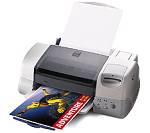 Targetted at digital camera users, the EPSON Stylus Photo 875DC includes a built-in PCMCIA digital film reader making the printer compatible with virtually any digital camera by using the appropriate adapter. Compatible digital film types include CompactFlash I and II, CompactFlash USB, SmartMedia I and II and Sony Memory Stick. The PCMCIA card slot allows users to view, edit and print images (computer required) or use pass-through file transferring to save the images directly to their computers. Acting as a hard drive, the film card launches Sierra Imaging's Image Expert photo editing software for immediate access to digital images. The EPSON Stylus Photo 875DC starter kit includes a CompactFlash Type II Adapter, a roll paper holder, plus Sierra Imaging Image Expert and Adobe Photo Deluxe software. The printer is Windows and Macintosh compatible and supports USB connectivity, making it the first printer to offer a built-in card slot compatible for Macintosh. It also has the same paper handling capabilities as the EPSON Stylus Photo 870. Targetted at digital camera users, the EPSON Stylus Photo 875DC includes a built-in PCMCIA digital film reader making the printer compatible with virtually any digital camera by using the appropriate adapter. Compatible digital film types include CompactFlash I and II, CompactFlash USB, SmartMedia I and II and Sony Memory Stick. The PCMCIA card slot allows users to view, edit and print images (computer required) or use pass-through file transferring to save the images directly to their computers. Acting as a hard drive, the film card launches Sierra Imaging's Image Expert photo editing software for immediate access to digital images. The EPSON Stylus Photo 875DC starter kit includes a CompactFlash Type II Adapter, a roll paper holder, plus Sierra Imaging Image Expert and Adobe Photo Deluxe software. The printer is Windows and Macintosh compatible and supports USB connectivity, making it the first printer to offer a built-in card slot compatible for Macintosh. It also has the same paper handling capabilities as the EPSON Stylus Photo 870.
Through a promotion running until December 31, 2000, Epson is offering customers up to $100 off any brand digital camera with the purchase of the EPSON Stylus Photo 870 ($50 rebate) or the EPSON Stylus Photo 875DC ($100 rebate). The offer applies to digital cameras purchased between August 1 and December 31, and printers purchased between October 1 and December 31, 2000, making the effective price of either photo printer only $199.
The EPSON Stylus Photo 870 and 875DC are sold through computer superstores and specialty retail and camera stores nationwide, as well as through mail order and Epson's online store. Each carries a one-year Epson Exchange Warranty, enabling customers to receive a replacement printer if a problem cannot be corrected by telephone technical support.
Source: Epson price-cut announcement on BizWire

Ofoto and Amazon.com join forces!
By David Etchells, The Imaging Resource
(Wednesday, October 4, 2000 - 12:00 EDT)
 Online etailer giant Amazon.com (and Imaging Resource content licensee) has relaunched their digital photography area, and announced a partnership with Ofoto to offer printing and framing services to Amazon's customers. The new site area is at www.amazon.com/photo, where you'll find a very complete collection of digicams and other photo accessories. (Including a pretty incredible deal on the Kodak DC280, "while supplies last", at only $397.94!) From our viewpoint, this looks like a huge win for Ofoto, given Amazon's 23 million customers. It's also significant in that this is the first time we've seen Amazon actually let part of their "site" appear on someone else's server: It's completely transparent to the user, but when you click on any links to Amazon's online printing services, you actually end up on an Ofoto server. Congratulations to both Ofoto and Amazon! Online etailer giant Amazon.com (and Imaging Resource content licensee) has relaunched their digital photography area, and announced a partnership with Ofoto to offer printing and framing services to Amazon's customers. The new site area is at www.amazon.com/photo, where you'll find a very complete collection of digicams and other photo accessories. (Including a pretty incredible deal on the Kodak DC280, "while supplies last", at only $397.94!) From our viewpoint, this looks like a huge win for Ofoto, given Amazon's 23 million customers. It's also significant in that this is the first time we've seen Amazon actually let part of their "site" appear on someone else's server: It's completely transparent to the user, but when you click on any links to Amazon's online printing services, you actually end up on an Ofoto server. Congratulations to both Ofoto and Amazon!
Source: Amazon.com Photo Store

Tuesday, October 3, 2000
ASK FUJIFILM! - IR Forums Exclusive!
By David Etchells, The Imaging Resource
(Tuesday, October 3, 2000 - 21:19 EDT)
 HAVE A QUESTION FOR FUJI? - Here's your chance! Fujifilm digicam product manager Darin Pepple will be monitoring the Fuji Discussion Area in the IR forums from now though the end of October. He'll answer any questions you might have about Fuji's digicam product line or technology. Interested in the capabilities of the new 4900? (We have one in for testing, it's looking like a great camera!) Want to know more about SuperCCD? Questions on software? Darin's your man! - Click the link above, or below to go directly to the discussion area and post your questions. Darin will be checking in periodically and answer the questions as they arise. (Thanks, Darin!) HAVE A QUESTION FOR FUJI? - Here's your chance! Fujifilm digicam product manager Darin Pepple will be monitoring the Fuji Discussion Area in the IR forums from now though the end of October. He'll answer any questions you might have about Fuji's digicam product line or technology. Interested in the capabilities of the new 4900? (We have one in for testing, it's looking like a great camera!) Want to know more about SuperCCD? Questions on software? Darin's your man! - Click the link above, or below to go directly to the discussion area and post your questions. Darin will be checking in periodically and answer the questions as they arise. (Thanks, Darin!)
Source: IR Forums ASK FUJIFILM discussion

Kodak announces DC3200 digital camera!
By Michael Tomkins, The Imaging Resource
(Tuesday, October 3, 2000 - 16:12 EDT)
The newest digital camera from Eastman Kodak Co. 'puts digital imaging within the budget of more Americans, just in time for the holiday picture-taking season', says the company in a BusinessWire press release on Yahoo! Finance. The new Kodak DC3200 combines 1-megapixel resolution and a 39mm-equivalent fixed focus lens, and offers images Kodak describes as 'perfect for e-mailing or printing at sizes up to 5 x 7 inches'.
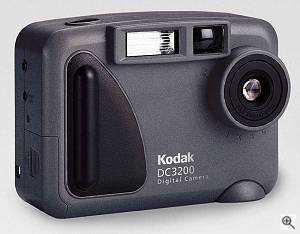 "The Kodak DC3200 digital camera will put digital picture-making into the hands of many more people this holiday season," said Philip Gerskovich, Kodak vice president, Digital & Applied Imaging. "It brings the most popular benefits of digital cameras - instant image viewing, simple operation and easy transfer - at a very affordable price point."  Designed for ease-of-use, the DC3200 digital camera features a 1.6-inch LCD screen and 2 MB of internal memory which stores up to 22 images. The camera is compatible with optional CompactFlash memory cards that can be inserted for additional picture storage. A 2X digital interpolation feature is also included. Designed for ease-of-use, the DC3200 digital camera features a 1.6-inch LCD screen and 2 MB of internal memory which stores up to 22 images. The camera is compatible with optional CompactFlash memory cards that can be inserted for additional picture storage. A 2X digital interpolation feature is also included.
Other features of the DC3200 digital camera include a built-in flash, optical viewfinder, serial and video-out connectivity and a DC-in port for use with an AC adapter. The DC3200 digital camera ships with a serial cable, four AA alkaline batteries (rechargeable Ni-MH batteries and charger are available as options), wrist strap, instructions and a CD with Kodak Picture Transfer and Kodak Pictures Now photo enhancement software. A Kodak Digital Camera Bonus Kit comprising an AC adapter, 4MB CompactFlash memory card, accent bag and micro-fiber, lens-cleaning cloth is available separately for a suggested retail price of $59.95.
The new camera is available now at selected retailers and has a suggested retail price of $249. Here's the full specs:- 1.2 megapixel (1280 x 960 pixel) CCD image sensor gives JPEG files of 1152 x 864 or 576 x 432 pixels in Best, Better or Good compression. 1.0 megapixel effective rating.
- 5.4mm f/3.6 fixed focus lens equivalent to 39mm on a 35mm camera. Focus fixed for a range of 0.6 meters to infinity. Lens cap not included.
- Optical viewfinder and 1.6" LCD display
- 2MB of Internal memory and CompactFlash slot
- Built-in 3-mode flash with range 1.5 to 2.4 meters (automatic, fill, off)
- Serial conectivity
- Video out connectivity (NTSC only for USA, NTSC/PAL for Canada). Video out cable not included
- Automatic exposure control
- Auto and three-preset manual white balance (daylight, fluorescent, tungsten)
- Shutter speeds from 1/4 to 1/500 second
- Apertures of f/3.6, f/8
- ISO rating of 100
- DPOF (Digital Print Order Format) compliant
- Power from 4 AA Alkaline batteries (included) or 4 AA NiMH batteries and charger (optional)
- Dimensions of 113 x 81 x 53.4mm, weighs 215 grams without batteries
- Bundled with wrist strap, software CD, serial cable, 4 AA alkaline batteries, and documentation
- Optional accessories include AC adapter, NiMH batteries and charger, video-out cable, lens cap and camera bag
- Available immediately at a cost of US$249
 Kodak has a "web demonstration" of the DC3200 digital camera on their website. Kodak has a "web demonstration" of the DC3200 digital camera on their website.
Source: Yahoo! Finance / Business Wire

Monday, October 2, 2000
UPDATED: Sanyo announces iDshot IDC-1000Z digicam!
By Michael Tomkins, The Imaging Resource
(Monday, October 2, 2000 - 17:27 EDT)
 Sanyo Electric Co. Ltd. has today announced its new IDC-1000Z 'iDshot' digital disk camera, the world's first to employ the 730MB iD PHOTO magneto-optical disk for image storage. Each iD PHOTO disk can fit roughly 2 hours of video recorded at 160 X 120 pixels, 15 frames per second, or about 11,000 640 x 480 pixel still images. The IDC-1000Z has a resolution of 1.5 megapixels and can capture video clips at up to 30 frames per second in 640 x 480, 320 x 200 or 160 x 120 pixel resolution. The iDshot is also the first digital camera to feature both IEEE 1394 (FireWire) and USB connectivity. It will go on sale in Japan December 8, 2000 at a manufacturer's suggested retail price of ¥160,000 / US$1483 (excluding tax). The first month's production is set at 10,000 units. Sanyo Electric Co. Ltd. has today announced its new IDC-1000Z 'iDshot' digital disk camera, the world's first to employ the 730MB iD PHOTO magneto-optical disk for image storage. Each iD PHOTO disk can fit roughly 2 hours of video recorded at 160 X 120 pixels, 15 frames per second, or about 11,000 640 x 480 pixel still images. The IDC-1000Z has a resolution of 1.5 megapixels and can capture video clips at up to 30 frames per second in 640 x 480, 320 x 200 or 160 x 120 pixel resolution. The iDshot is also the first digital camera to feature both IEEE 1394 (FireWire) and USB connectivity. It will go on sale in Japan December 8, 2000 at a manufacturer's suggested retail price of ¥160,000 / US$1483 (excluding tax). The first month's production is set at 10,000 units.
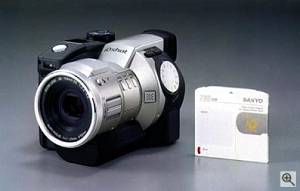
The iDshot is, says Sanyo, "based on the concept of 'High Balance Still & Motion'". The camera's video clips are claimed to offer the same qualityas S-VHS VCR systems while also offering high-definition 'Still Images'. The 'iD Format' media standards were developed jointly by SANYO, Olympus Optical Co., Ltd. and Hitachi Maxell Ltd.
The 'iD PHOTO' disk is described in the press release as "the industry's leading media for achieving high-speed data transmission, renowned for its rugged durability and high reliability against shock [and] ultraviolet rays". iD PHOTO disks are also rewriteable, allowing the user to reuse the disks after copying images to another media, or to free up space on a disk when away from a computer by deleting unwanted images. Sanyo notes that it will actively promote the development of products that employ new media in the future. Each 'iD PHOTO' disk should have a cost of less than ¥5 per megabyte. The disks have a write speed of 20Mbps and a recording capacity of 730MB
The iDshot's ability to capture 30 frames per second, 640 x 480-pixel video is achieved thanks to a HRPG (Hyper RISC Graphic Processor), the press release notes. The camera uses the 'Quick Time Movie' format. A 'VPmi X' (Vertical Pixel Mixture) CCD is used, which allows signal conversion to moving image and still images through one CCD. Moving images are captured by switching to a vertical pixel mixer mode, whilst the full pixel modeis used when photographing still images.
 With both IEEE 1394 and USB connectivity, the iDshot promises high-speed transfer necessary when you consider that it can store up to 730MB of still image and video data. Files can also be copied to the camera as well, allowing the camera to be used as a mobile 'iD PHOTO' drive as well. To the computer, it appears to be a normal hard-disk drive. With both IEEE 1394 and USB connectivity, the iDshot promises high-speed transfer necessary when you consider that it can store up to 730MB of still image and video data. Files can also be copied to the camera as well, allowing the camera to be used as a mobile 'iD PHOTO' drive as well. To the computer, it appears to be a normal hard-disk drive.
The 'iDshot' also features an interval timer which allows both for capturing of still images at preset intervals, or for capturing of movie frames at intervals, allowing for time-lapse video.
Here's the full specs:
- Sanyo iDshot ICD-1000Z digital camera
- 1/2" 1.5 megapixel RGBG interlaced CCD image sensor, 1.4 megapixel effective rating.
- JPEG and YCbCr TIFF format still images in resolutions of 1360 x 1024, 1024 x 768 and 640 x 480.
- 7-21mm 3x optical zoom lens equivalent to 38-114mm on a 35mm camera.F2.4 (wide) - 4.4 (Tele). Auto focus. Built-in ND filter(?). Focuses 60cm - infinity, or 3cm (wide) / 20cm (tele) - 60cm in macro mode.
- 110,000 pixel 1.8" low temperature polysilicon TFT LCD display and 0.55" LCD optical viewfinder with diopter adjustment
- Uses 730MB iD PHOTO disks for storage. Disks are rewriteable magneto-optical using CAD-MSR "magnetic super resolution technology" and laser pulse magnetic field modulation recording. Stores up to 260 TIFF, 1000 JPEG Fine, or 2000 JPEG Normal images at full resolution
- 4-pin IEEE 1394 (FireWire) and USB connectivity. Optional (¥15,000 / US$139) 'Personal Computer Connection Kit' PCK-1000 includes IEEE1394 and USB cables and image/video editing software.
- Video out (NTSC) and microphone in connectivity
- Built-in monaural microphone and speaker
- Built-in flash with auto, off, on and red-eye reduction settings. Guide number of 6.8. Flash sync 1/30 to 1/500 second.
- Program AE, Aperture Priority and Shutter Priority modes. +/- 1.5EV exposure compensation in 0.5EV steps. Center-weighted or spot metering
- Shutter speeds 1, 2, 3, 4, 8 & 16 - 1/500 second (normal), 1/15 - 1/2000 second (high speed), 1/30 - 1/2000 second (video).
- ISO ratings of 100, 200, 400 and Auto
- Auto white balance with manual override
- Burst-mode of 7.5 frames per second at 1360 x 1024 and 1024 x 768, 30 frames per second at 640 x 480
- QuickTime MotionJPEG-conforming MOV video clips at resolutions of 640 x 480, 320 x 200 and 160 x 120. Maximum length of video clip 8 minutes at 640 x 480 30fps, 20 minutes at 320 x 200 30fps, 60 minutes at 160 x 120 30fps. Double this at 15 fps for each resolution.
- 8-bit 8KHz Monaural PCM WAV format sound clips
- 10 second self-timer
- Dimensions of 92.8 x 88.3 x 139.3 millimeters. Weight of 525 grams without battery, 621 grams with battery.
- Power from UR-121 Lithium Ion battery or AC adapter/charger (included). Extra batteries cost ¥8500 / US$79 each.
- Bundled with iD PHOTO disk, Li-Ion battery, charger, remote control, lithium button battery, lens cap, hand/neck straps, and AV cable.
Updated: 10/03/00 03:22EST to include full specifications
Source: Sanyo's English iDshot IDC-1000Z announcement

Olympus C-2100 UltraZoom now available!
By Michael Tomkins, The Imaging Resource
(Monday, October 2, 2000 - 16:30 EDT)
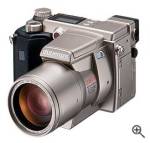 We just posted news over on the Deals page that Olympus' C-2100 UltraZoom digital camera is now shipping! The C-2100's 2.1 megapixel resolution might not be the highest on the market, but we reckon that its image-stabilising 10x optical zoom lens alone is worth its weight in gold, and when Steve Sanders over at the Steve's Digicams website reviewed the camera, he seemed to agree: We just posted news over on the Deals page that Olympus' C-2100 UltraZoom digital camera is now shipping! The C-2100's 2.1 megapixel resolution might not be the highest on the market, but we reckon that its image-stabilising 10x optical zoom lens alone is worth its weight in gold, and when Steve Sanders over at the Steve's Digicams website reviewed the camera, he seemed to agree:"With all the other digicams I've had to review in the last month (and that's a bunch) the one that I've had the most fun with is the Olympus C-2100UZ. This camera performs wonderfully under every kind of shooting environment from indoor flash to outdoor sports. It has the same zoom capabilities as Sony's FD95 or CD1000 but in a smaller, lighter and faster camera.
The 10x stabilized zoom is great, once you use it you'll wonder how you ever managed to get by with a 3x or even a 5x lens. The stabilization system allows handheld shots at full telephoto that are sharp and clear. It also lets you capture shots at much slower shutter speeds than you'd attempt with other cameras. If you like candid shots, you'll love the ability to shoot family and friends from half a block away. They'll never even know you were there. Switch it into macro mode and capture closeup shots of flowers and small things from five feet away, or get so close that the lens just about touches your subject." Be sure to check out Steve's review if you haven't done so already, and then hop on over to the Deals page to find out where you can get this gem of a camera for $999... But hurry, there's only 20 of these cameras left in stock, and we confidently predict they'll fly off the shelves. :)

UPDATED: Steve's Digicams reviews the PowerShot G1!
By Michael Tomkins, The Imaging Resource
(Monday, October 2, 2000 - 16:04 EDT)
 Our friend Steve over at the excellent Steve's Digicams website has posted a first-look review of Canon's new PowerShot G1 digital camera over the weekend. In case you missed it when we first reported on the camera back on September 18th, the PowerShot G1 features a 3.34 megapixel CCD image sensor, 3x optical zoom lens, CompactFlash storage, USB connectivity, tilt/swivel LCD display, intelligent external flash hot-shoe, and full manual capability (shutter, aperture, white balance and focusing). There's no conclusions drawn as yet in Steve's review, but plenty of in-depth description of the camera, as well as numerous sample photos... Check it out! Our friend Steve over at the excellent Steve's Digicams website has posted a first-look review of Canon's new PowerShot G1 digital camera over the weekend. In case you missed it when we first reported on the camera back on September 18th, the PowerShot G1 features a 3.34 megapixel CCD image sensor, 3x optical zoom lens, CompactFlash storage, USB connectivity, tilt/swivel LCD display, intelligent external flash hot-shoe, and full manual capability (shutter, aperture, white balance and focusing). There's no conclusions drawn as yet in Steve's review, but plenty of in-depth description of the camera, as well as numerous sample photos... Check it out!
Our friends over at the Digital Photography Review website have also posted a review of the PowerShot G1. In-depth as usual, Phil's review includes a look at camera operation, a comparison with Nikon's Coolpix 990 camera, and numerous sample photos. Phil concludes:"When you take the whole package and the fact that image quality is at least on par with the 990 (some colours are certainly more saturated) then it's easy to see why the G1 now looks like the choice digital camera for the prosumer looking for a 3 megapixel digital camera. Ok, so Canon are about 6 months late to market and we're all expecting new cameras at PMA next year but, just in time for Christmas. Canon's built an excellent prosumer digital camera and I'm sure it'll become first choice for many people." Be sure and hop on over to Phil's review if you're interested in the PowerShot G1!
Updated: 10/03/00 03:25EST to add a link to the Digital Photography Review's PowerShot G1 review
Source: Steve's Digicams' Canon PowerShot G1 first-look review


AOL Alert: Several readers connecting
via AOL have complained of poor image quality when using the AOL web browser.
This is caused by a setting called "compress images" in the browser
that causes it to completely mangle images in the interest of faster transmission.
You should turn this setting OFF before viewing any of the comparison images
on this site.
- FLASH: Thanks to reader Lynn Mannan, here's an explanation of how to
make the correct settings adjustments (at least in AOL 4.0 for PCs):

- I opened the "My AOL" preferences screen
in the toolbar across the top. Then I clicked on WWW icon and selected
the "web graphics" tab where I unchecked the "compressed
graphics" choice and clicked on the Apply button at the bottom. Now
the scanner test pictures are gorgeous. The pictures take a long time to
load. But they are worth waiting for. Thank
you, Lynn!
|
 |
|